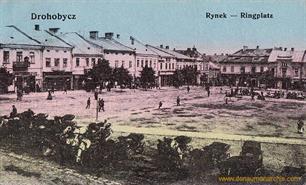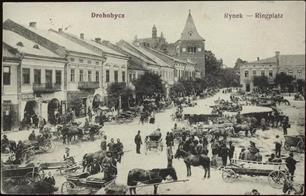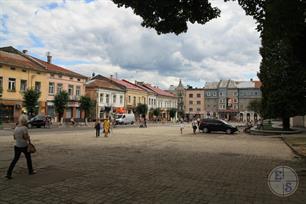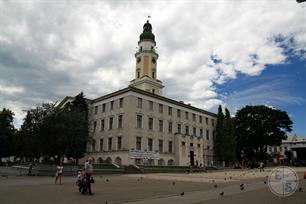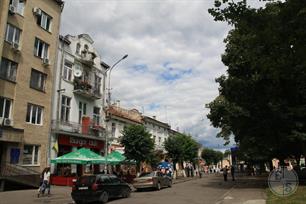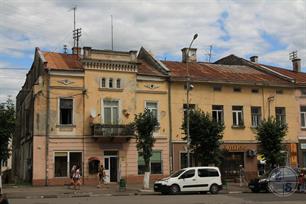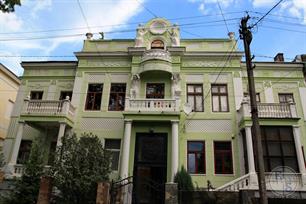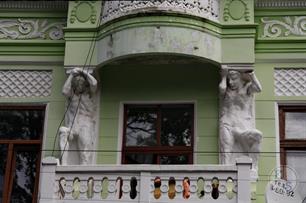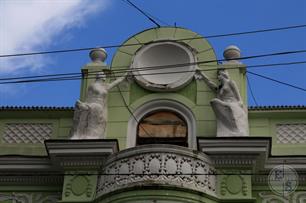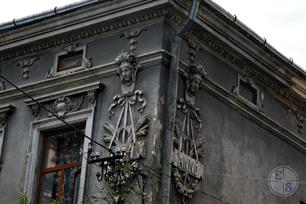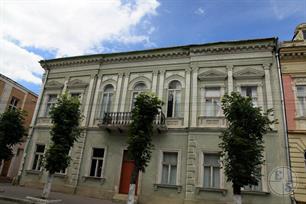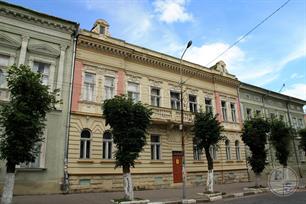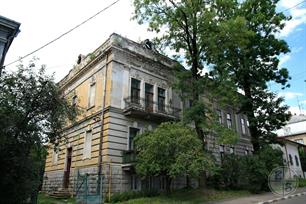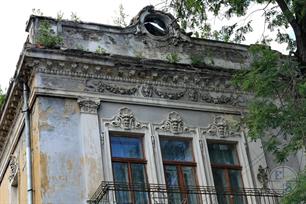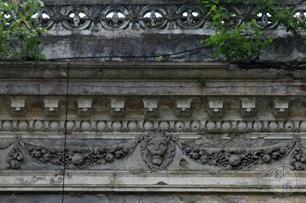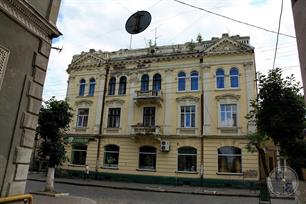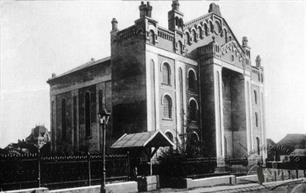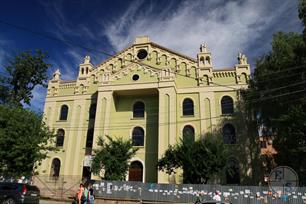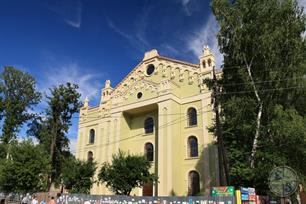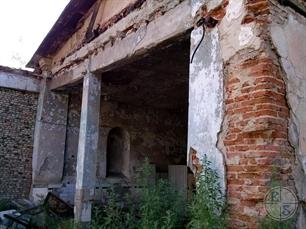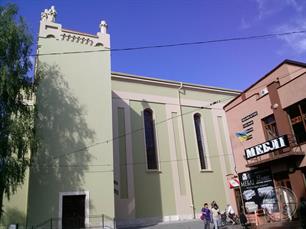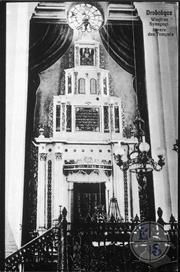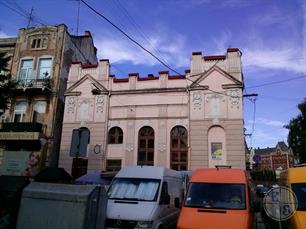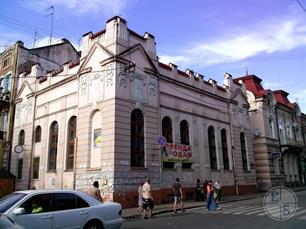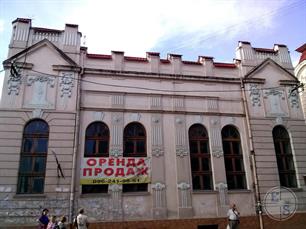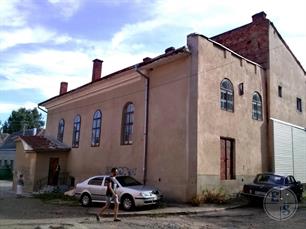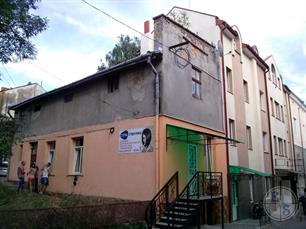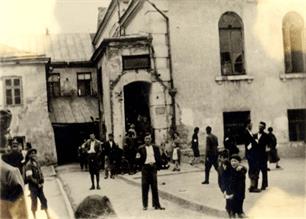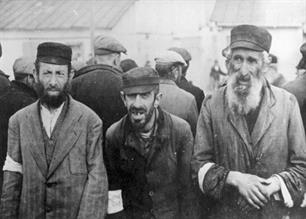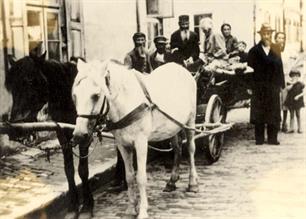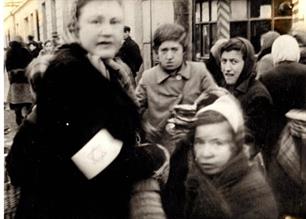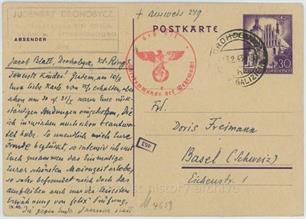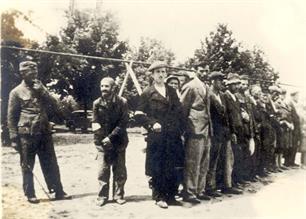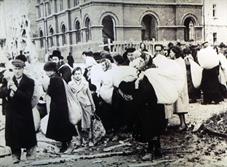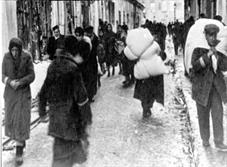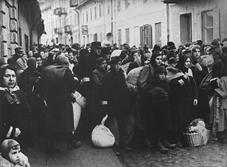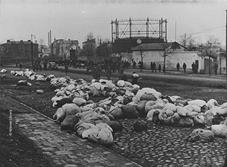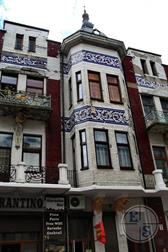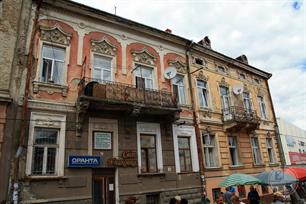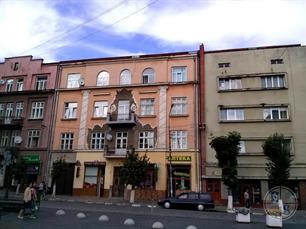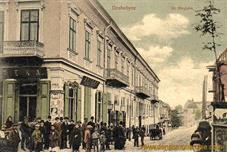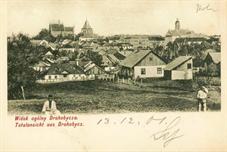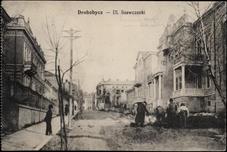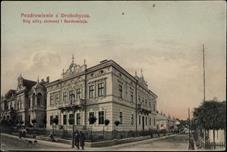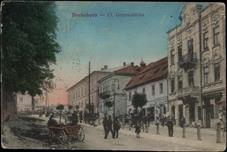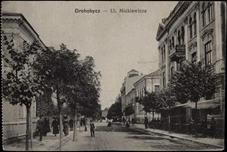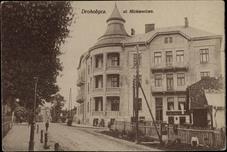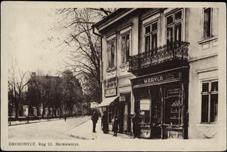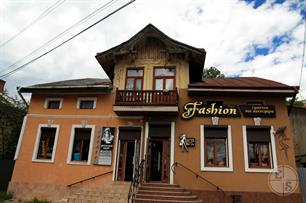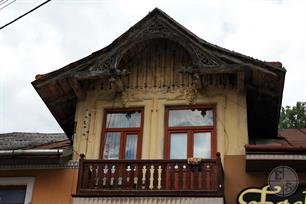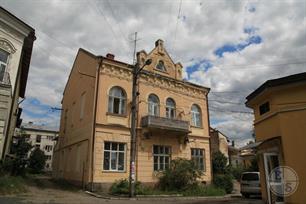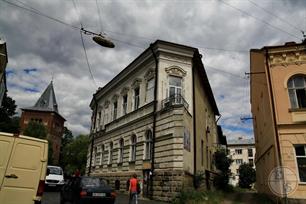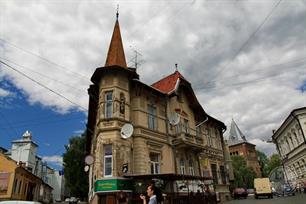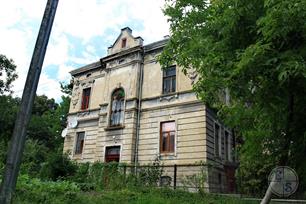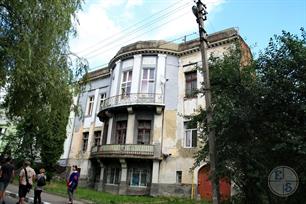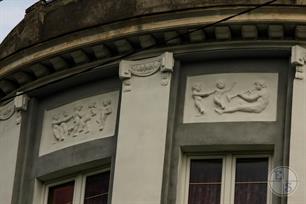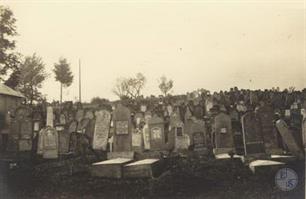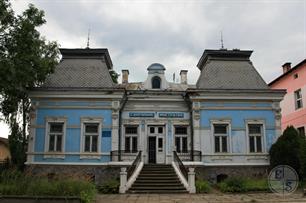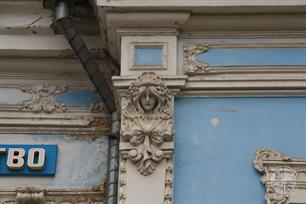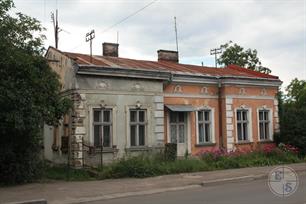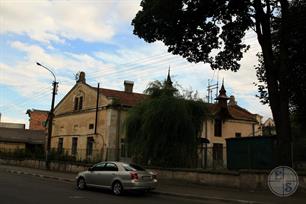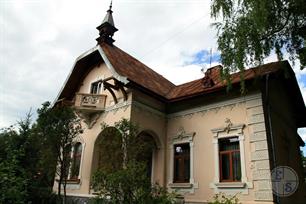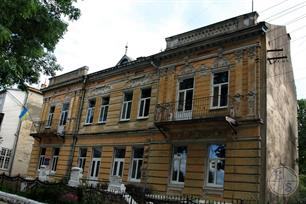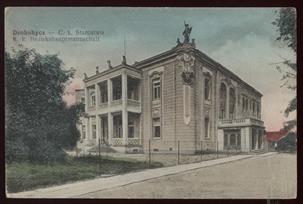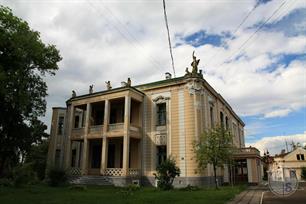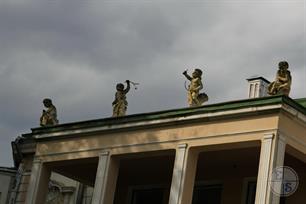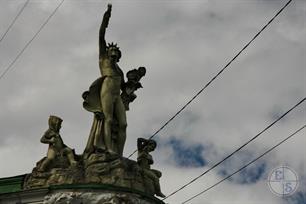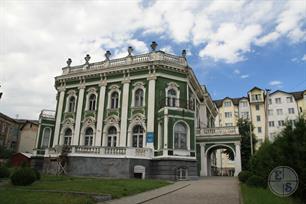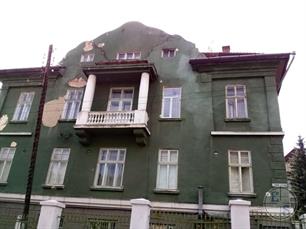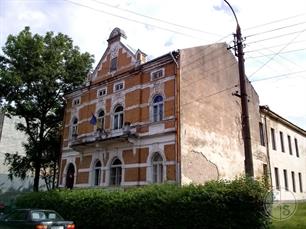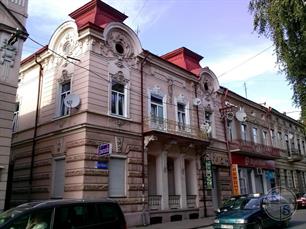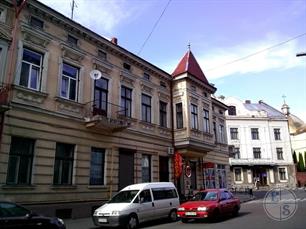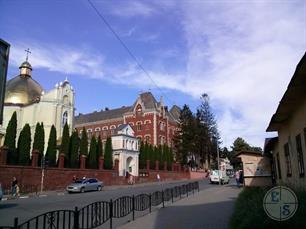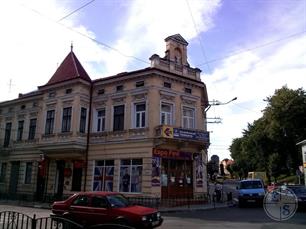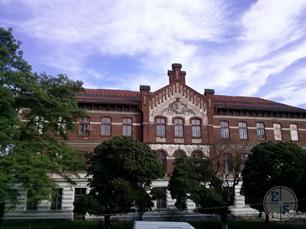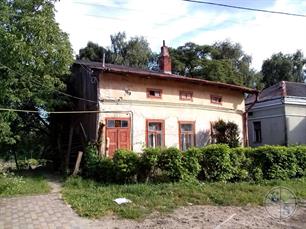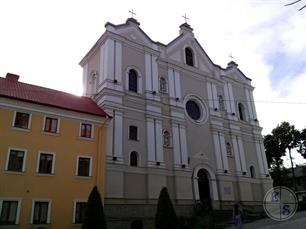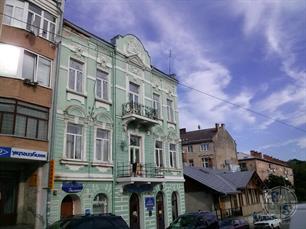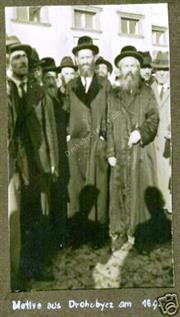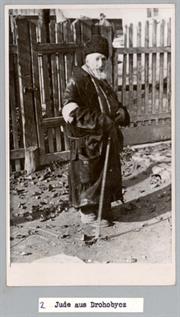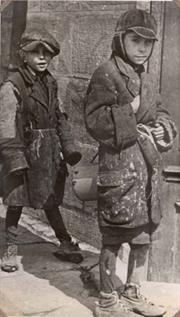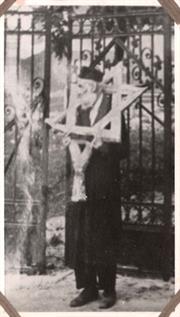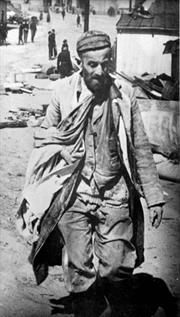Drohobycz
Lviv region
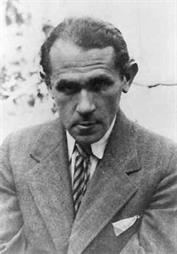 |
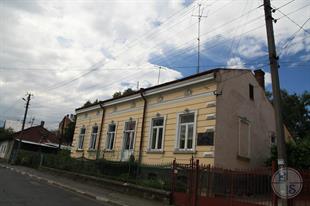 |
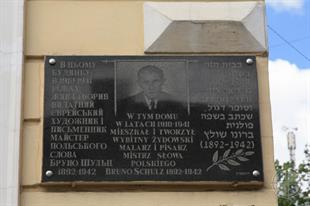 |
| Bruno Shults | Writer's house | |
 |
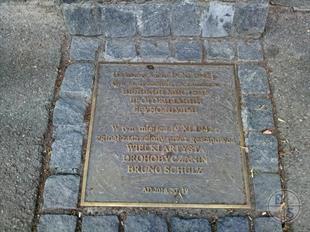 |
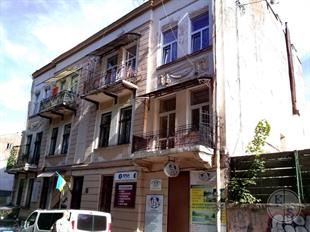 |
| In this gymnasium he worked | The place of death of Bruno Schulz | The German was shooting from the balcony of this house ... |
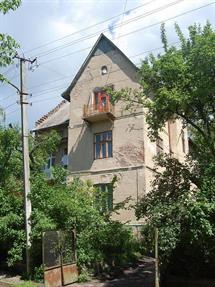 |
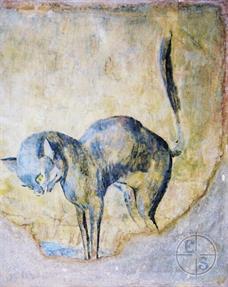 |
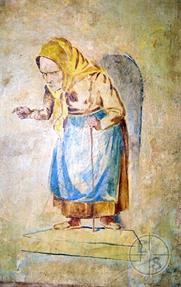 |
| Villa Landau | Frescoes based on the tales of the Brothers Grimm | |
 |
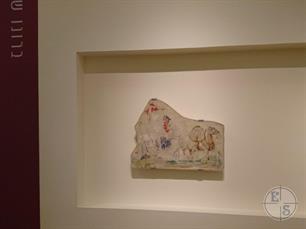 |
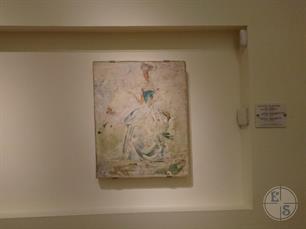 |
| These 3 murals are in the Yad Vashem Museum in Jerusalem |
From the town's establishment until 1772
Drohobycz is mentioned for the first time in the 11th century. In the 14th century it was part of a kingdom that endured until 1771. In 1392, a church was built there and in time, Drohobycz became an important religious centre. The population was employed in extracting salt from the mines around the town and exporting it. Drohobycz was the centre of governance for a network of settlements in the area, as it was under Austrian rule as well. With the discovery of oil in nearby Borysław in the middle of the 19th century, drilling and processing of oil became the town's main industry.
During the years of Polish independence, the prosperity of the town was at its height. After World War II, it became part of Western Ukraine under the Soviet regime and was a regional city.
The first references to Jews in Drohobycz dates back to 1404. The first Jews were not allowed to live within the town, just on its outskirts. Because the Jews were not allowed to have their own cemetery, an independent kehilla was not established until later.
At the beginning of the 15th century, the Jews of Drohobycz were engaged mainly in the extraction of salt. In 1425, a Jew called Detko, who was in the salt business, dealt with Kiev and Turkey. Detko also supplied the king and had financial dealings with his court. Shimshon from Źydaczуw searched for salt deposits around the years 1471-1474 and greatly expanded the market for salt to other countries in Europe.
From 1504, the king granted the salt rights to Yaakov Yuditz of Drohobycz. At the same time, the Jews received permission to import lumber for house construction. Collection of some of the tax revenue was also in the hands of Jews. The growing influence of the Jews in Drohobycz was not received well by the inhabitants of the town. In 1569, the Jews brought this to the attention of the king. Representatives from the town tried to restrain the privileges granted to the Jewish residents of the town and in 1578, their request was granted. Jews were forbidden to live in the city, not even outside its walls. They were not allowed to mine or carry on their businesses, participate in fairs or gather in fenced-off meeting places. Jews who remained in the town for more than three days were subjected to heavy fines. As a result of these decrees, there were no Jews in Drohobycz for fifty-four years. It was only in 1635, that the government of Reisin allowed the Jews to live in the outskirts of the town but still they were not allowed to have their own cemetery. The reason given for these restrictions was to preserve the Christian character of the town after it had been destroyed by fire by the Tatars in 1618. Jews once again occupied themselves in the sale of salt and tax collecting. With the appearance in 1648 of the Cossacks in area, a sizeable number of Jews went to Stryj.
In 1663, fifteen Jews owned homes in Na Lanie. At that time, most Jews were involved with the production of beer and liquor. In the 1760s, the inhabitants of Drohobycz tried once more to expel the Jews. The Jews of the kehilla were organized and resisted this rigorously, citing the privileges that they had received previously from the Polish king. They succeeded in defeating the town's protest. In 1664, there were a number of liquor shops in Na Lanie.
Drohobycz is mentioned for the first time in the 11th century. In the 14th century it was part of a kingdom that endured until 1771. In 1392, a church was built there and in time, Drohobycz became an important religious centre. The population was employed in extracting salt from the mines around the town and exporting it. Drohobycz was the centre of governance for a network of settlements in the area, as it was under Austrian rule as well. With the discovery of oil in nearby Borysław in the middle of the 19th century, drilling and processing of oil became the town's main industry.
During the years of Polish independence, the prosperity of the town was at its height. After World War II, it became part of Western Ukraine under the Soviet regime and was a regional city.
The first references to Jews in Drohobycz dates back to 1404. The first Jews were not allowed to live within the town, just on its outskirts. Because the Jews were not allowed to have their own cemetery, an independent kehilla was not established until later.
At the beginning of the 15th century, the Jews of Drohobycz were engaged mainly in the extraction of salt. In 1425, a Jew called Detko, who was in the salt business, dealt with Kiev and Turkey. Detko also supplied the king and had financial dealings with his court. Shimshon from Źydaczуw searched for salt deposits around the years 1471-1474 and greatly expanded the market for salt to other countries in Europe.
From 1504, the king granted the salt rights to Yaakov Yuditz of Drohobycz. At the same time, the Jews received permission to import lumber for house construction. Collection of some of the tax revenue was also in the hands of Jews. The growing influence of the Jews in Drohobycz was not received well by the inhabitants of the town. In 1569, the Jews brought this to the attention of the king. Representatives from the town tried to restrain the privileges granted to the Jewish residents of the town and in 1578, their request was granted. Jews were forbidden to live in the city, not even outside its walls. They were not allowed to mine or carry on their businesses, participate in fairs or gather in fenced-off meeting places. Jews who remained in the town for more than three days were subjected to heavy fines. As a result of these decrees, there were no Jews in Drohobycz for fifty-four years. It was only in 1635, that the government of Reisin allowed the Jews to live in the outskirts of the town but still they were not allowed to have their own cemetery. The reason given for these restrictions was to preserve the Christian character of the town after it had been destroyed by fire by the Tatars in 1618. Jews once again occupied themselves in the sale of salt and tax collecting. With the appearance in 1648 of the Cossacks in area, a sizeable number of Jews went to Stryj.
In 1663, fifteen Jews owned homes in Na Lanie. At that time, most Jews were involved with the production of beer and liquor. In the 1760s, the inhabitants of Drohobycz tried once more to expel the Jews. The Jews of the kehilla were organized and resisted this rigorously, citing the privileges that they had received previously from the Polish king. They succeeded in defeating the town's protest. In 1664, there were a number of liquor shops in Na Lanie.
The leaders of the kehilla came to an agreement with the mayor of the town to restrict Jews from residing elsewhere in the city. They also agreed that the Jews should not fall under the jurisdiction of the town council but rather, under the administration of the Wojwode. By 1678, with the agreement of the town authorities, the number of shops owned by Jews had increased to forty. The kehilla began to grow and slowly Jews began to move into the city itself despite the official restrictions.
At first, the Drohobycz kehilla was under the governance of the kehilla of Przemyśl. It became independent in the 1760s.
In 1670, Reb Yekutiel Zalman Segal, the head of the kharif, was appointed as rabbi of Drohobycz, a position he held for ten years. In 1680, Reb Tzvi Hirsch took over this positin. Following him, Reb Yehudah ben Yaakov served as rabbi and Reb Naftali Hirsch followed him. At the beginning of the 18th century, one of the most important rabbis of his generation, Reb Yitzhak Khajes (1660-1726) served the town. He was a well-known kabbalist and a strong opponent of Shabtai Tzvi.
During the reign of the Polish king Jan Sobieski (1679-1696), who did much for the improvement of the life of Jews in Drohobycz, the Jewish settlement in the town began to grow substantially. The number of Jewish shops grew steadily and Jews became the primary merchants and dealers. On September 8, 1685, the town took the Jewish community to court claiming that they were disobeying the law. The Jews rejected this charge and on March 18, 1686, the king issued an order that the Jews were not to be prevented from conducting their businesses and that their shops and liquor businesses were to remain in their hands until the king's council would decide the matter. The king announced that the Jews would be permitted to live outside the city's boundaries. In 1688, a dispute erupted once again between the town's Gentiles and Jews. Again, the king decided in favour of the Jews. In another case, the king prohibited the Jewish merchant Liebermann from operating his business close to the church. In this case, the court accepted the claim that Jewish activity was detrimental to the town.
At the end of the 17th century, the areas in which Jews could live were expanded in all the surrounding villages. The head of the kehilla, Yosef Yosefovitz, became the tax collector and responsible for the salt trade in the town and its environs.
At the beginning of the 18th century, the Jews of Drohobycz dominated trade in the town. Salt production and trade expanded and exports increased. Merchants from Drohobycz would attend fairs in Breslau, Frankfurt, Danzig, Kцnigsberg, Leipzig and other German cities. Competition in the salt market was great between the Drohobycz dealers and Jewish merchants from Lwуw who sold the salt at a lower price than the salt from Buchacz and Kalisz. Meat merchants from Drohobycz would buy herds of animals by the hundreds and sell them in the Silesian markets.
There were wholesalers as well as retailers in Drohobycz. Jews with capital were also active in the financial markets in the area and throughout Poland.
In 1716, the number of Jews increased to 200 families. During the years 1716 and 1717, there were three tailors, two jewelers, one tinsmith, one furrier, one bookbinder, one painter, one barber, and three bakers. In 1728, there were six tailors, two tinsmiths and two jewelers. In 1765, there were six barbers, seven tinsmiths, sixteen tailors and four furriers.
At first, the Drohobycz kehilla was under the governance of the kehilla of Przemyśl. It became independent in the 1760s.
In 1670, Reb Yekutiel Zalman Segal, the head of the kharif, was appointed as rabbi of Drohobycz, a position he held for ten years. In 1680, Reb Tzvi Hirsch took over this positin. Following him, Reb Yehudah ben Yaakov served as rabbi and Reb Naftali Hirsch followed him. At the beginning of the 18th century, one of the most important rabbis of his generation, Reb Yitzhak Khajes (1660-1726) served the town. He was a well-known kabbalist and a strong opponent of Shabtai Tzvi.
During the reign of the Polish king Jan Sobieski (1679-1696), who did much for the improvement of the life of Jews in Drohobycz, the Jewish settlement in the town began to grow substantially. The number of Jewish shops grew steadily and Jews became the primary merchants and dealers. On September 8, 1685, the town took the Jewish community to court claiming that they were disobeying the law. The Jews rejected this charge and on March 18, 1686, the king issued an order that the Jews were not to be prevented from conducting their businesses and that their shops and liquor businesses were to remain in their hands until the king's council would decide the matter. The king announced that the Jews would be permitted to live outside the city's boundaries. In 1688, a dispute erupted once again between the town's Gentiles and Jews. Again, the king decided in favour of the Jews. In another case, the king prohibited the Jewish merchant Liebermann from operating his business close to the church. In this case, the court accepted the claim that Jewish activity was detrimental to the town.
At the end of the 17th century, the areas in which Jews could live were expanded in all the surrounding villages. The head of the kehilla, Yosef Yosefovitz, became the tax collector and responsible for the salt trade in the town and its environs.
At the beginning of the 18th century, the Jews of Drohobycz dominated trade in the town. Salt production and trade expanded and exports increased. Merchants from Drohobycz would attend fairs in Breslau, Frankfurt, Danzig, Kцnigsberg, Leipzig and other German cities. Competition in the salt market was great between the Drohobycz dealers and Jewish merchants from Lwуw who sold the salt at a lower price than the salt from Buchacz and Kalisz. Meat merchants from Drohobycz would buy herds of animals by the hundreds and sell them in the Silesian markets.
There were wholesalers as well as retailers in Drohobycz. Jews with capital were also active in the financial markets in the area and throughout Poland.
In 1716, the number of Jews increased to 200 families. During the years 1716 and 1717, there were three tailors, two jewelers, one tinsmith, one furrier, one bookbinder, one painter, one barber, and three bakers. In 1728, there were six tailors, two tinsmiths and two jewelers. In 1765, there were six barbers, seven tinsmiths, sixteen tailors and four furriers.
During the first half of the 18th century, trade connections between the Jews of Drohobycz and Hungary grew. The main products imported to Drohobycz were spices and wine.
As the population grew, the institutions of the kehilla expanded. At the beginning of the 17th century, a synagogue was built and in 1711, the bishop of Przemyśl permitted it to be enlarged. In the 1720s, this synagogue was destroyed by fire. After much effort, the Jews received permission from the bishop to rebuild the temple in the same place provided that the structure would be neither taller nor more beautiful than the former building. In 1733, the Jews were granted permission to erect a fence around the Jewish cemetery in exchange for repairing and maintaining the Roman Catholic church.
In 1718, a well-known woman in Drohobycz was accused of blood libel. Madame Adele, who was head of a large business enterprise in the town, was accused of killing a Gentile child in her house on the eve of Passover. In reality, one of her maids had brought the child to the house and killed him. Using torture, the investigators extracted a confession from Adele that she had killed the child, even though it was untrue. She confessed to prevent the entire Jewish community from being victimized. Adele herself was sentenced to death. However, when the servant heard the decree she regretted the decision and admitted publicly that she had killed the child. She even identified the Gentile person who had planned the deed. The priests were so angry with this that they did not want to reveal or admit the truth and carried out Adele's death sentence.
By the beginning of the 18th century, the institutions of the kehilla were firmly established. In 1765, the kehilla was extended to include the Jewish residents of eighty-six villages around Drohobycz. Drohobycz was part of the council of Reisin and its representatives played an active role in the administration of the religious government of the state. Sometimes the leaders of the Drohobycz kehilla opposed the decisions of the council of Reisin. For example, in 1756, together with the kehilla of Dolina, they complained about high taxes.
Between the years 1729 and 1755, Zalman ben Zaiv played a central role in the Jewish community of Drohobycz. By building his contacts with the Polish community and particularly through his relationship with the wife of the Starosta, he controlled the kehilla. With the help of his large family and by other means, Zalman ben Zaiv eliminated competition and assumed control of the sale of salt throughout the network of villages in the area, as well as the wholesale business in wine and iron. He was also able, in certain respects, to gain influence over the non-Jewish population as well. As a result, the Christian leaders of the town became angry at this state of affairs. For about twenty-five years, despite several collaborative efforts between the Jews and non-Jews in Drohobycz to dislodge him, he managed to retain his position. It was only in 1755 that the Polish government in Warsaw sentenced him to death for his misdeeds and abuse of the Christian population of the city. Although the Jewish leaders of the kehilla had also wanted to bring him to justice, they managed to have his death sentence changed to life imprisonment. Zalman's attempt to escape from prison affected the attitude of Christians toward the Jews of Drohobycz for an entire generation.
The second half of the 18th century marked the spread of khasidic influence in the kehilla. Leaders of the khasidic movement were Reb Yitzhak Drohobyczer and Reb Yosef Drohobyczer (Aszkenazi).
In 1813, there were six Karaite families in Drohobycz, ten men and thirteen women.
As the population grew, the institutions of the kehilla expanded. At the beginning of the 17th century, a synagogue was built and in 1711, the bishop of Przemyśl permitted it to be enlarged. In the 1720s, this synagogue was destroyed by fire. After much effort, the Jews received permission from the bishop to rebuild the temple in the same place provided that the structure would be neither taller nor more beautiful than the former building. In 1733, the Jews were granted permission to erect a fence around the Jewish cemetery in exchange for repairing and maintaining the Roman Catholic church.
In 1718, a well-known woman in Drohobycz was accused of blood libel. Madame Adele, who was head of a large business enterprise in the town, was accused of killing a Gentile child in her house on the eve of Passover. In reality, one of her maids had brought the child to the house and killed him. Using torture, the investigators extracted a confession from Adele that she had killed the child, even though it was untrue. She confessed to prevent the entire Jewish community from being victimized. Adele herself was sentenced to death. However, when the servant heard the decree she regretted the decision and admitted publicly that she had killed the child. She even identified the Gentile person who had planned the deed. The priests were so angry with this that they did not want to reveal or admit the truth and carried out Adele's death sentence.
By the beginning of the 18th century, the institutions of the kehilla were firmly established. In 1765, the kehilla was extended to include the Jewish residents of eighty-six villages around Drohobycz. Drohobycz was part of the council of Reisin and its representatives played an active role in the administration of the religious government of the state. Sometimes the leaders of the Drohobycz kehilla opposed the decisions of the council of Reisin. For example, in 1756, together with the kehilla of Dolina, they complained about high taxes.
Between the years 1729 and 1755, Zalman ben Zaiv played a central role in the Jewish community of Drohobycz. By building his contacts with the Polish community and particularly through his relationship with the wife of the Starosta, he controlled the kehilla. With the help of his large family and by other means, Zalman ben Zaiv eliminated competition and assumed control of the sale of salt throughout the network of villages in the area, as well as the wholesale business in wine and iron. He was also able, in certain respects, to gain influence over the non-Jewish population as well. As a result, the Christian leaders of the town became angry at this state of affairs. For about twenty-five years, despite several collaborative efforts between the Jews and non-Jews in Drohobycz to dislodge him, he managed to retain his position. It was only in 1755 that the Polish government in Warsaw sentenced him to death for his misdeeds and abuse of the Christian population of the city. Although the Jewish leaders of the kehilla had also wanted to bring him to justice, they managed to have his death sentence changed to life imprisonment. Zalman's attempt to escape from prison affected the attitude of Christians toward the Jews of Drohobycz for an entire generation.
The second half of the 18th century marked the spread of khasidic influence in the kehilla. Leaders of the khasidic movement were Reb Yitzhak Drohobyczer and Reb Yosef Drohobyczer (Aszkenazi).
In 1813, there were six Karaite families in Drohobycz, ten men and thirteen women.
From Unification with Austria to World War I (1914)
When Galicia became part of the Austrian Empire, the Drohobycz City Council withdrew the rights that the Jews had been granted in the town in former times. During the debate that occurred over this matter, the non-Jews were victorious. This decision struck a severe blow to the Jews of Drohobycz. The salt trade was now under the jurisdiction of the Austrian government and out of Jewish control. Some Jews managed to obtain sub-contracts from the government but they had no ability to set the price of salt.
At the end of the 18th century, the Jews of Drohobycz began to dig for oil that had been discovered in the area. At the beginning, the process of digging for the oil was very primitive. It was used mainly for wagon wheels and for tanning leather. Oil extraction did not intensify until the second half of the nineteenth century.
After the town had succeeded in overturning the rights of the Jews, its government appealed to the Austrian authorities to expel the Jews from the centre of the town to the suburb of Na Lanie where they had lived in previous centuries, They also demanded that the Jews be restricted from practicing any trade in the town. In 1794, the prohibition of Jews from residing in Drohobycz was proclaimed and they were forced to move to Na Lanie. This proclamation threatened the disintegration of the kehilla in Drohobycz.
In spite of the order, the Jews fought for their rights. A few weeks after the order was enacted, the leaders of the kehilla appealed to the Austrian government in Vienna to allow them to remain in their houses in the town. As a result, the ban on doing business in the town was repealed. Despite the fact that the Austrians had relieved the restrictions, some of the Christian inhabitants of Drohobycz broke into Jewish homes and forced them to leave the city. The Jews of Austria were also burdened by onerous taxes. In 1792, the burden of debt upon the kehilla, still in effect from the time of Polish rule, amounted to 26,968 crowns.
When Galicia became part of the Austrian Empire, the Drohobycz City Council withdrew the rights that the Jews had been granted in the town in former times. During the debate that occurred over this matter, the non-Jews were victorious. This decision struck a severe blow to the Jews of Drohobycz. The salt trade was now under the jurisdiction of the Austrian government and out of Jewish control. Some Jews managed to obtain sub-contracts from the government but they had no ability to set the price of salt.
At the end of the 18th century, the Jews of Drohobycz began to dig for oil that had been discovered in the area. At the beginning, the process of digging for the oil was very primitive. It was used mainly for wagon wheels and for tanning leather. Oil extraction did not intensify until the second half of the nineteenth century.
After the town had succeeded in overturning the rights of the Jews, its government appealed to the Austrian authorities to expel the Jews from the centre of the town to the suburb of Na Lanie where they had lived in previous centuries, They also demanded that the Jews be restricted from practicing any trade in the town. In 1794, the prohibition of Jews from residing in Drohobycz was proclaimed and they were forced to move to Na Lanie. This proclamation threatened the disintegration of the kehilla in Drohobycz.
In spite of the order, the Jews fought for their rights. A few weeks after the order was enacted, the leaders of the kehilla appealed to the Austrian government in Vienna to allow them to remain in their houses in the town. As a result, the ban on doing business in the town was repealed. Despite the fact that the Austrians had relieved the restrictions, some of the Christian inhabitants of Drohobycz broke into Jewish homes and forced them to leave the city. The Jews of Austria were also burdened by onerous taxes. In 1792, the burden of debt upon the kehilla, still in effect from the time of Polish rule, amounted to 26,968 crowns.
In 1906, the organization Ezra founded a school modeled after Safra Brura. That year, 150 male and 126 female students were enrolled. In 1907, six courses were offered there to about 100 students. At the end of the school year the school was closed because of financial difficulties. When it reopened in 1911, there were 150 students who studied seven courses. The school existed until the outbreak of World War I. In 1910, a yeshiva was opened in the town.
At the beginning of the century, there was an attempt to open a Jewish vocational training school specializing in the petroleum industry but this effort did not succeed. The Jewish students went to public trade schools.
In 1901, a club called Toynbee Ha'eleh formed in the town; it became the centre of cultural life in the following years. There, lectures were given, plays performed, and choruses and musical groups gave concerts. The women's group Moriah carried on cultural activities, especially for women and children. Near the club Ivreyeh, there was a reading room and a library containing hundreds of books. In 1910, Bet Am Yehudah was established; it also became a cultural centre for the Jews of Drohobycz.
A number of maskilim, who were active in Drohobycz in the 19th century, left their imprint on the spiritual life of the town. Zelig Lauterbach (1826-1904) published articles in Hatsir Hamvaser and Gesher and wrote commentaries on the Shas and on legends of the Talmud and its commentaries. He also wrote novels and poetry. Some of his works appeared outside Galicia. He founded a reading room in Drohobycz in which there was a library. There he made available a large collection of books on Jewish subjects.
A haskala writer, Schmuel Abraham Apfel (1831-1892), who was active in Drohobycz from 1865, had great influence on the maskilim of throughout Galicia. He also served on the City Council. In 1850, he began publishing poems and commentaries on the Tanakh in Kokhvei Yitzhak. He translated one of Schiller's plays into Hebrew in 1888. Apfel also wrote a book called Kisharon Hakhokhsma and Mapakehfesh, Czernowitz, 1883, and a humorous poem in Yiddish, Zum nayem yor.
In addition to his communal work as head of the kehilla, Alexander Chaim Shor, who died in 1913, wrote Hebrew poems that were collected under the title Kokhvei Yitzhak, He also published articles in Hamashber, Hamagid Ivrei Anokhi and in the 1880s he contributed to Tna Hamlitza, published in Czernowitz.
Aron Hersch Zupnik (1848-1917) settled in Drohobycz in 1866. His writings appeared in Hamashber, Hamagid and Hashakhar. In his writings he analyzed Jewish education. In 1883, he opened a Hebrew printing press in Drohobycz and published a German language weekly using Hebrew letters. This weekly was called Drohobyczer Zeitung. His intention was to spread the ideas of the German enlightenment among the Jews of Galicia. From time to time there was a Hebrew edition. He also translated Ludwig Philipson's Kdushat Hashem into Hebrew and wrote a biography of the first Jewish preacher in Lwуw that was endorsed by the more religious groups.
Yehoshua Liebermann was also one of the maskilim in Drohobycz. He published translations in Kokhvei Yitzhak (1865-1866) as well as articles in Hamashber.
Hermann Sternbach (1880-died during World War II) in addition to his works on the enlightenment, wrote poems in German, translated Roman literature into German, and wrote articles about literature that appeared in a Zionist paper.
Professor Leon Sternbach, who was born in Drohobycz, was a world-renowned scholar in classical languages who lectured at the Universities of Lwуw and Krakуw.
Yakob Levy (1819-1892), also born in Drohobycz, was a lexicographer of Aramaic and early Hebrew languages.
The kehilla of Drohobycz produced four famous artists from the Gottlieb family: Maurycy, Leopold, Martin and Philip.
On September 16 1914, the Russians overran the city. A few hundred Jews managed to flee. Upon entering the town, the Cossacks rampaged, raped and even killed. When the Russian authorities closed the kehilla institutions, this caused great hardship for aid organizations since the damage increased throughout the months of occupation. Many Jewish homes were destroyed when the town was captured in May and June of 1915. With the return of the Austrians on June 3, 1915, Jewish life improved to some extent and some of those who had fled the city returned. On November 2 1918, there was another shock for the Jews of Drohobycz when the town came under the jurisdiction of the Western Ukrainian Republic. The life of the kehilla changed and became less important. In its place, a Jewish City Council was established. This became part of the Jewish national Council whose headquarters was in Stanislawуw. The Jewish Council in Drohobycz opened public kitchens to feed those who had been ruined during the war. During the period under Ukrainian rule, Jews were not involved in the oil industry. Life was not easy for the Jews when bands of Ukrainian farmers, who lived in the villages surrounding Drohobycz, caused trouble.
In 1919, elections were held for the National Jewish Council of Drohobycz and resulted in thirteen Mizrachi members being elected and another twenty from Poale Zion, groups of orthodox Jews and some trades people.
In April and May 1919, the Ukrainian soldiers attacked the Jews of the city under the accusation that they were favouring the Polish forces. In May 1919, Drohobycz was captured by a unit of the Polish army. On that day there were savage attacks on the Jews and many were robbed of their property. It was only after the Polish government gained power that these attacks stopped.
At the beginning of the century, there was an attempt to open a Jewish vocational training school specializing in the petroleum industry but this effort did not succeed. The Jewish students went to public trade schools.
In 1901, a club called Toynbee Ha'eleh formed in the town; it became the centre of cultural life in the following years. There, lectures were given, plays performed, and choruses and musical groups gave concerts. The women's group Moriah carried on cultural activities, especially for women and children. Near the club Ivreyeh, there was a reading room and a library containing hundreds of books. In 1910, Bet Am Yehudah was established; it also became a cultural centre for the Jews of Drohobycz.
A number of maskilim, who were active in Drohobycz in the 19th century, left their imprint on the spiritual life of the town. Zelig Lauterbach (1826-1904) published articles in Hatsir Hamvaser and Gesher and wrote commentaries on the Shas and on legends of the Talmud and its commentaries. He also wrote novels and poetry. Some of his works appeared outside Galicia. He founded a reading room in Drohobycz in which there was a library. There he made available a large collection of books on Jewish subjects.
A haskala writer, Schmuel Abraham Apfel (1831-1892), who was active in Drohobycz from 1865, had great influence on the maskilim of throughout Galicia. He also served on the City Council. In 1850, he began publishing poems and commentaries on the Tanakh in Kokhvei Yitzhak. He translated one of Schiller's plays into Hebrew in 1888. Apfel also wrote a book called Kisharon Hakhokhsma and Mapakehfesh, Czernowitz, 1883, and a humorous poem in Yiddish, Zum nayem yor.
In addition to his communal work as head of the kehilla, Alexander Chaim Shor, who died in 1913, wrote Hebrew poems that were collected under the title Kokhvei Yitzhak, He also published articles in Hamashber, Hamagid Ivrei Anokhi and in the 1880s he contributed to Tna Hamlitza, published in Czernowitz.
Aron Hersch Zupnik (1848-1917) settled in Drohobycz in 1866. His writings appeared in Hamashber, Hamagid and Hashakhar. In his writings he analyzed Jewish education. In 1883, he opened a Hebrew printing press in Drohobycz and published a German language weekly using Hebrew letters. This weekly was called Drohobyczer Zeitung. His intention was to spread the ideas of the German enlightenment among the Jews of Galicia. From time to time there was a Hebrew edition. He also translated Ludwig Philipson's Kdushat Hashem into Hebrew and wrote a biography of the first Jewish preacher in Lwуw that was endorsed by the more religious groups.
Yehoshua Liebermann was also one of the maskilim in Drohobycz. He published translations in Kokhvei Yitzhak (1865-1866) as well as articles in Hamashber.
Hermann Sternbach (1880-died during World War II) in addition to his works on the enlightenment, wrote poems in German, translated Roman literature into German, and wrote articles about literature that appeared in a Zionist paper.
Professor Leon Sternbach, who was born in Drohobycz, was a world-renowned scholar in classical languages who lectured at the Universities of Lwуw and Krakуw.
Yakob Levy (1819-1892), also born in Drohobycz, was a lexicographer of Aramaic and early Hebrew languages.
The kehilla of Drohobycz produced four famous artists from the Gottlieb family: Maurycy, Leopold, Martin and Philip.
On September 16 1914, the Russians overran the city. A few hundred Jews managed to flee. Upon entering the town, the Cossacks rampaged, raped and even killed. When the Russian authorities closed the kehilla institutions, this caused great hardship for aid organizations since the damage increased throughout the months of occupation. Many Jewish homes were destroyed when the town was captured in May and June of 1915. With the return of the Austrians on June 3, 1915, Jewish life improved to some extent and some of those who had fled the city returned. On November 2 1918, there was another shock for the Jews of Drohobycz when the town came under the jurisdiction of the Western Ukrainian Republic. The life of the kehilla changed and became less important. In its place, a Jewish City Council was established. This became part of the Jewish national Council whose headquarters was in Stanislawуw. The Jewish Council in Drohobycz opened public kitchens to feed those who had been ruined during the war. During the period under Ukrainian rule, Jews were not involved in the oil industry. Life was not easy for the Jews when bands of Ukrainian farmers, who lived in the villages surrounding Drohobycz, caused trouble.
In 1919, elections were held for the National Jewish Council of Drohobycz and resulted in thirteen Mizrachi members being elected and another twenty from Poale Zion, groups of orthodox Jews and some trades people.
In April and May 1919, the Ukrainian soldiers attacked the Jews of the city under the accusation that they were favouring the Polish forces. In May 1919, Drohobycz was captured by a unit of the Polish army. On that day there were savage attacks on the Jews and many were robbed of their property. It was only after the Polish government gained power that these attacks stopped.
Between the two World Wars
When the Jews left the city during the war, many industries, trades and businesses closed. The period of Ukrainian rule made the economic crisis even worse. Many Jewish families were badly affected.
At the beginning of the 1920s, there were 150 enterprises in Jewish hands. Of the 1,493 employees who worked in them 30 percent were Jews. Among the workers in these enterprises, 10.5 percent were owners and their families while 89.5 percent were hired workers. Among the hired workers, 34.3 percent were Jews. 26.3 percent of those who worked in the chemical industry were Jews. In 1927, there were around 100 lawyers in Drohobycz. In the 1930s Jewish workers were divided as follows: 32.2 percent in trade and commerce, 29 percent crafts and industrial workers, 13.9 percent office workers and managers, 9.9 percent free trades.
In 1925, the City Council decided to do away with one of the town markets. This represented a threat to the livelihoods of many Jewish merchants who had shops and stands in the market. Many went out of business. In the same year there was a great crisis in the oil industry when hundreds of Jews were fired from their jobs.
Jewish merchants had to withstand strong competition from Polish merchants. The Polish merchants were supported by the government that placed heavy taxes on Jewish trade and industry in the city. The union of Jewish employees that had been established in 1913 began to operate again in 1926 and worked on behalf of the Jewish merchants. Tradesmen were organized into two groups, Yad Kharutzim and Igud Merkazi. The two groups united in 1933. The Jewish business owners were also badly hit. For example, the shoe-making business was adversely affected in 1933 when the Bata shoe factory was established.
Industrialists, merchants and tradesmen established a chain of financial aid institutions and mutual aid groups. In 1920, a bank for tradesmen called Habank Hamiskhari was founded and at the beginning of the 1930s, Bank Miskhari Amani, Kupat Amanit, as well as a chain of other free loan societies.
Jewish professional unions were also established for refinery workers, Jewish office workers, workers in the oil industry, barbershop employees (that was eliminated under the Polish regime for political reasons), bakers and confection workers.
In 1937, an agricultural union was formed with 300 Jewish families who worked in agriculture close to the city.
Also in the 1930s around twenty-five percent of Jews were unemployed. About 400 Jews were registered for financial aid from the tradesmen's funds in 1935, around 500 in 1936, and 883 in 1937.
In order to alleviate the dire need, communal kitchens were opened. The most outstanding was Khevra L'tmikha Bgrush that distributed daily more than 100 lunch meals for children and around 150 for adults. In that year, a total of 48, 836 meals were served. The fact that in 1925 around 500 families were given food aid at Passover indicates how great the poverty was. In 1937, 1,031 families, that meant 5,150 Jews in total who represented 40 percent of the total Jewish population in the city, received aid. A branch of Ta'az that was established in this period administered medical aid, particularly among young people.
During World War I, Zionist activities in Drohobycz were renewed. Between 1919 and 1939, there were branches of all Zionist parties in the city. There were general Zionists and radical Zionists connected with Al Hamishmar, the revisionists from 1933, another party, Mifleget Hamedina, Hitakhadut, and in 1932, the Poale Zion. In 1933, a branch of Haoved was founded whose membership consisted of sons of tradesmen from the Zionist socialists. Mizrachi was another party. There was also a WIZO group that had 300 women members in 1930.
All the Zionist youth groups were also represented in Drohobycz: Gordonia, Busliya, Hashomer Hatzair, B'nai Akiva, HaNoar Hatzioni, Betar, Hatikvah, Akhiva Khevronya, a local Theodore Herzl group, and young WIZO. There were also groups of Hekhalutz and Hekhalutz of the General Zionists in Drohobycz. In the 1930s, a Hakhsharo (training farm) of the General Zionists Hekhaitz movement was founded.
In 1938, an umbrella organization called Merkaz Noar for all the Zionist youth groups was founded in the town. The group offered Hebrew courses and there were around 200 students enrolled that year. There was also a communal choir for the members.
When the Jews left the city during the war, many industries, trades and businesses closed. The period of Ukrainian rule made the economic crisis even worse. Many Jewish families were badly affected.
At the beginning of the 1920s, there were 150 enterprises in Jewish hands. Of the 1,493 employees who worked in them 30 percent were Jews. Among the workers in these enterprises, 10.5 percent were owners and their families while 89.5 percent were hired workers. Among the hired workers, 34.3 percent were Jews. 26.3 percent of those who worked in the chemical industry were Jews. In 1927, there were around 100 lawyers in Drohobycz. In the 1930s Jewish workers were divided as follows: 32.2 percent in trade and commerce, 29 percent crafts and industrial workers, 13.9 percent office workers and managers, 9.9 percent free trades.
In 1925, the City Council decided to do away with one of the town markets. This represented a threat to the livelihoods of many Jewish merchants who had shops and stands in the market. Many went out of business. In the same year there was a great crisis in the oil industry when hundreds of Jews were fired from their jobs.
Jewish merchants had to withstand strong competition from Polish merchants. The Polish merchants were supported by the government that placed heavy taxes on Jewish trade and industry in the city. The union of Jewish employees that had been established in 1913 began to operate again in 1926 and worked on behalf of the Jewish merchants. Tradesmen were organized into two groups, Yad Kharutzim and Igud Merkazi. The two groups united in 1933. The Jewish business owners were also badly hit. For example, the shoe-making business was adversely affected in 1933 when the Bata shoe factory was established.
Industrialists, merchants and tradesmen established a chain of financial aid institutions and mutual aid groups. In 1920, a bank for tradesmen called Habank Hamiskhari was founded and at the beginning of the 1930s, Bank Miskhari Amani, Kupat Amanit, as well as a chain of other free loan societies.
Jewish professional unions were also established for refinery workers, Jewish office workers, workers in the oil industry, barbershop employees (that was eliminated under the Polish regime for political reasons), bakers and confection workers.
In 1937, an agricultural union was formed with 300 Jewish families who worked in agriculture close to the city.
Also in the 1930s around twenty-five percent of Jews were unemployed. About 400 Jews were registered for financial aid from the tradesmen's funds in 1935, around 500 in 1936, and 883 in 1937.
In order to alleviate the dire need, communal kitchens were opened. The most outstanding was Khevra L'tmikha Bgrush that distributed daily more than 100 lunch meals for children and around 150 for adults. In that year, a total of 48, 836 meals were served. The fact that in 1925 around 500 families were given food aid at Passover indicates how great the poverty was. In 1937, 1,031 families, that meant 5,150 Jews in total who represented 40 percent of the total Jewish population in the city, received aid. A branch of Ta'az that was established in this period administered medical aid, particularly among young people.
During World War I, Zionist activities in Drohobycz were renewed. Between 1919 and 1939, there were branches of all Zionist parties in the city. There were general Zionists and radical Zionists connected with Al Hamishmar, the revisionists from 1933, another party, Mifleget Hamedina, Hitakhadut, and in 1932, the Poale Zion. In 1933, a branch of Haoved was founded whose membership consisted of sons of tradesmen from the Zionist socialists. Mizrachi was another party. There was also a WIZO group that had 300 women members in 1930.
All the Zionist youth groups were also represented in Drohobycz: Gordonia, Busliya, Hashomer Hatzair, B'nai Akiva, HaNoar Hatzioni, Betar, Hatikvah, Akhiva Khevronya, a local Theodore Herzl group, and young WIZO. There were also groups of Hekhalutz and Hekhalutz of the General Zionists in Drohobycz. In the 1930s, a Hakhsharo (training farm) of the General Zionists Hekhaitz movement was founded.
In 1938, an umbrella organization called Merkaz Noar for all the Zionist youth groups was founded in the town. The group offered Hebrew courses and there were around 200 students enrolled that year. There was also a communal choir for the members.
Additional parties in the city were: Agudat Yisrael and the youth group of Agudat Yisrael, the Bundand its youth branch Tzukunft (The Future). A sizeable group of Jews were members of the illegal Communist Party.
In 1921, a mixed group called Ikhu was formed. They conducted a strong anti-Zionist campaign. There was also a group of Jewish soldiers in the city who had been discharged from serving in Pilsudski's regiments.
At the beginning of the 1920s, there was a struggle for power in the Council by individuals of the mitbolilem who were sometimes supported by the orthodox religious groups and the Zionists. In the elections for the Council in 1924, the Zionists received 1,124 votes from 1,284 eligible voters. The joint list of Agudat Yisroel and the mitbolilem was defeated. Until 1928, the Council of the Drohobycz kehilla was functioning jointly with the nearby city of Borysław and a number of small kehillot in the area. At the beginning of that year, separate Councils were established.
In the elections to the Council of the kehilla in Drohobycz, the Zionists won the majority in 1927. There were fourteen representatives in the Zionist parties, two for Agudat Yisroel, two on the list of tradesmen, and two on the Makhzikei Hada'at. In 1937, most of the parties united for the election. Only Hitakhdut and the Bund put up separate candidates for the elections of the Council but did not succeed in getting their representatives elected.
The Council of the kehilla found itself in financial difficulties and was unable to supply the most basic needs for the Jewish population. Things did not bode well for the kehilla because the need was so great and the funds were decreasing. In 1927, it had a budget of 208,130 zlotys, in 1935, 195,810 zlotys and in 1937, 141,600 zlotys.
The Council provided the essentials for such institutions as the Old Folks' Home, the orphanage, and also participated in various other institutions, such as the hospital, a kindergarten and the Talmud Torah. In 1925, the Council prepared a plan for a Jewish cemetery.
In 1925, there were nine Jews on the City Council from a total of thirty-six members, even though Jews constituted forty-five percent of the population and paid about eighty percent of the taxes. In the city elections of 1934, the Jews gained eleven seats, the Poles fifteen and the Ukrainians, six. Leon Tannenbaum continued as Vice Mayor, a position he held until 1928. In the 1939 elections, the Jews once again had eleven representatives in the City Council.
Between 1918 and 1939, there were many houses of prayer in the city, many of which existed from former days. Among them was the Great Synagogue that stood at the crossroads of the Jewish square, Lan. Beside it was a house of study and prayer. There were also small synagogues of the Zidtzov Khasidim of Rav Lauterbach, Yashir Leiv and a house of study and prayer, Khevrat Kdashim of the Sadigora khasidim. Beside this small synagogue, the first yeshiva of Drohobycz was opened after World War I. Reb Mekemanno's khasidic followers added their own small synagogue. The Temple was used as a house of prayer and cultural centre for the enlightened Jews. In the 1930s a second Temple was built.
Rav Reb Chaim Yechiel Shapiro had his own courtyard. He was referred to as Reb Chaimonov and came from a chain of distinguished rabbis. He was close to the ideology of the Zionists and to Zionist groups. Because of this, the more religious groups looked upon him unfavourably. In 1921, Reb Chayim Yechiel moved to the land of Israel with his entire family. The rabbi of Drohobycz between the two World Wars was Yaakov Avigdor, a writer and a man of science with the title of Doctor and author of the book, Avir Yaakov.
Between the years 1918 and 1939, most of the Jewish children of Drohobycz studied in the public schools. Among the graduates of the Polish gymnasium who received graduation certificates was a relatively large percentage of Jews. There were eighteen Jews among the forty-three students who received graduation diplomas in 1936. Of ten graduates in one gymnasium class in 1935, there were six Jews. In the two private gymnasia for girls, most of the students in the 1930s were Jewish. In the Polish commercial high school more than half the pupils were Jews.
In addition, in the general educational institutions, both elementary and technical, there were Jewish children. There was also a system for Jewish education in the city as well. In a private Jewish high school, named after Leon Sternbach, where the language of instruction was Polish, there were 904 students in the school year of 1938-1939. There was a plan to convert this into a bilingual school with Polish and Hebrew. In the middle 1930s, the Council of the kehilla decided to build a boys' vocational school. However, this never materialized due to financial difficulties and because the war broke out.
Religious education was given mainly at the Talmud Torah. Those who finished their studies there continued to study in the Metivbah yeshiva. In 1927, a Bais Yaakov school was founded and 120 girls studied there in 1928.
There were a number of Jewish kindergartens in Drohobycz. In some of them, the children received a Hebrew education. There were also courses for Hebrew in the town organized by the Tarbut and B'nai Yehuda organization. The Zionist organizations also gave Hebrew courses. Youth groups were particularly active in these classes. Groups of adults broadened their general education at the university named after Albert Einstein.
Habayit HaYehudi was a centre for cultural activities. Drama groups performed and lectures and Hebrew courses were given there. In 1927, a special reading room especially for students was opened. It had an orchestra and a choir that performed in the town and in the surrounding villages. The cultural club next to WIZO attracted many women and served as a place for cultural and social events. In the 1930s there was a Moadon Khevruh (social club) that served the intelligentsia of the town. The Agudah L'Haskalah Amanit organized lectures of a popular nature for a broad range of groups in the kehilla. At the beginning of the 1920s a Jewish theatre operated on the premises. In spite of difficulties, it continued to function with interruptions until 1939. The stage actor, Hart, was its head for a period. There was also a dramatic group named after Yaacov Gordon led by the Drohobycz singer Tuvya Adler and a drama group named after Anski. Near the Temple, there was a rich library for Jewish studies. There was also a branch of YIVO in Drohobycz.
In the sports club Beitar, there were exercise groups, light athletics, tennis and skating. In the Jewish Sport Club there was a well-known soccer team. The Jewish Sports Club developed many sport activities. The Jewish Athletic Club conducted exercises for young and old. The sport club, Stern, that was part of the Bund was closed by the government in 1934 for political reasons.
Anti-Semitic attacks were a part of Jewish life in Drohobycz in the period between 1918 and 1939. At the end of the 1920s there were attacks against Jews led by Ukrainians. They targeted merchants and Jewish peddlers who came in contact with farmers in the area. In 1930, there were anti-Semitic outbreaks by gangs. In 1936, some Jews of Drohobycz were wounded by Ukrainian attackers. In the city itself, seven Jewish houses were attacked in that year. In December 1938, windowpanes in the synagogue were smashed. In 1939, attempts were made to damage other synagogues. The Polish government did nothing to punish the perpetrators.
In 1921, a mixed group called Ikhu was formed. They conducted a strong anti-Zionist campaign. There was also a group of Jewish soldiers in the city who had been discharged from serving in Pilsudski's regiments.
At the beginning of the 1920s, there was a struggle for power in the Council by individuals of the mitbolilem who were sometimes supported by the orthodox religious groups and the Zionists. In the elections for the Council in 1924, the Zionists received 1,124 votes from 1,284 eligible voters. The joint list of Agudat Yisroel and the mitbolilem was defeated. Until 1928, the Council of the Drohobycz kehilla was functioning jointly with the nearby city of Borysław and a number of small kehillot in the area. At the beginning of that year, separate Councils were established.
In the elections to the Council of the kehilla in Drohobycz, the Zionists won the majority in 1927. There were fourteen representatives in the Zionist parties, two for Agudat Yisroel, two on the list of tradesmen, and two on the Makhzikei Hada'at. In 1937, most of the parties united for the election. Only Hitakhdut and the Bund put up separate candidates for the elections of the Council but did not succeed in getting their representatives elected.
The Council of the kehilla found itself in financial difficulties and was unable to supply the most basic needs for the Jewish population. Things did not bode well for the kehilla because the need was so great and the funds were decreasing. In 1927, it had a budget of 208,130 zlotys, in 1935, 195,810 zlotys and in 1937, 141,600 zlotys.
The Council provided the essentials for such institutions as the Old Folks' Home, the orphanage, and also participated in various other institutions, such as the hospital, a kindergarten and the Talmud Torah. In 1925, the Council prepared a plan for a Jewish cemetery.
In 1925, there were nine Jews on the City Council from a total of thirty-six members, even though Jews constituted forty-five percent of the population and paid about eighty percent of the taxes. In the city elections of 1934, the Jews gained eleven seats, the Poles fifteen and the Ukrainians, six. Leon Tannenbaum continued as Vice Mayor, a position he held until 1928. In the 1939 elections, the Jews once again had eleven representatives in the City Council.
Between 1918 and 1939, there were many houses of prayer in the city, many of which existed from former days. Among them was the Great Synagogue that stood at the crossroads of the Jewish square, Lan. Beside it was a house of study and prayer. There were also small synagogues of the Zidtzov Khasidim of Rav Lauterbach, Yashir Leiv and a house of study and prayer, Khevrat Kdashim of the Sadigora khasidim. Beside this small synagogue, the first yeshiva of Drohobycz was opened after World War I. Reb Mekemanno's khasidic followers added their own small synagogue. The Temple was used as a house of prayer and cultural centre for the enlightened Jews. In the 1930s a second Temple was built.
Rav Reb Chaim Yechiel Shapiro had his own courtyard. He was referred to as Reb Chaimonov and came from a chain of distinguished rabbis. He was close to the ideology of the Zionists and to Zionist groups. Because of this, the more religious groups looked upon him unfavourably. In 1921, Reb Chayim Yechiel moved to the land of Israel with his entire family. The rabbi of Drohobycz between the two World Wars was Yaakov Avigdor, a writer and a man of science with the title of Doctor and author of the book, Avir Yaakov.
Between the years 1918 and 1939, most of the Jewish children of Drohobycz studied in the public schools. Among the graduates of the Polish gymnasium who received graduation certificates was a relatively large percentage of Jews. There were eighteen Jews among the forty-three students who received graduation diplomas in 1936. Of ten graduates in one gymnasium class in 1935, there were six Jews. In the two private gymnasia for girls, most of the students in the 1930s were Jewish. In the Polish commercial high school more than half the pupils were Jews.
In addition, in the general educational institutions, both elementary and technical, there were Jewish children. There was also a system for Jewish education in the city as well. In a private Jewish high school, named after Leon Sternbach, where the language of instruction was Polish, there were 904 students in the school year of 1938-1939. There was a plan to convert this into a bilingual school with Polish and Hebrew. In the middle 1930s, the Council of the kehilla decided to build a boys' vocational school. However, this never materialized due to financial difficulties and because the war broke out.
Religious education was given mainly at the Talmud Torah. Those who finished their studies there continued to study in the Metivbah yeshiva. In 1927, a Bais Yaakov school was founded and 120 girls studied there in 1928.
There were a number of Jewish kindergartens in Drohobycz. In some of them, the children received a Hebrew education. There were also courses for Hebrew in the town organized by the Tarbut and B'nai Yehuda organization. The Zionist organizations also gave Hebrew courses. Youth groups were particularly active in these classes. Groups of adults broadened their general education at the university named after Albert Einstein.
Habayit HaYehudi was a centre for cultural activities. Drama groups performed and lectures and Hebrew courses were given there. In 1927, a special reading room especially for students was opened. It had an orchestra and a choir that performed in the town and in the surrounding villages. The cultural club next to WIZO attracted many women and served as a place for cultural and social events. In the 1930s there was a Moadon Khevruh (social club) that served the intelligentsia of the town. The Agudah L'Haskalah Amanit organized lectures of a popular nature for a broad range of groups in the kehilla. At the beginning of the 1920s a Jewish theatre operated on the premises. In spite of difficulties, it continued to function with interruptions until 1939. The stage actor, Hart, was its head for a period. There was also a dramatic group named after Yaacov Gordon led by the Drohobycz singer Tuvya Adler and a drama group named after Anski. Near the Temple, there was a rich library for Jewish studies. There was also a branch of YIVO in Drohobycz.
In the sports club Beitar, there were exercise groups, light athletics, tennis and skating. In the Jewish Sport Club there was a well-known soccer team. The Jewish Sports Club developed many sport activities. The Jewish Athletic Club conducted exercises for young and old. The sport club, Stern, that was part of the Bund was closed by the government in 1934 for political reasons.
Anti-Semitic attacks were a part of Jewish life in Drohobycz in the period between 1918 and 1939. At the end of the 1920s there were attacks against Jews led by Ukrainians. They targeted merchants and Jewish peddlers who came in contact with farmers in the area. In 1930, there were anti-Semitic outbreaks by gangs. In 1936, some Jews of Drohobycz were wounded by Ukrainian attackers. In the city itself, seven Jewish houses were attacked in that year. In December 1938, windowpanes in the synagogue were smashed. In 1939, attempts were made to damage other synagogues. The Polish government did nothing to punish the perpetrators.
World War II
In September 1939, a few days after the outbreak of the war, thousands of refugees who were on their way to Romania, arrived in Drohobycz. Among them were thousands of Jews. The kehilla proposed that the refugees be put up in private houses and community institutions and supplied them with food. Some of the Jewish refugees continued on their way to the Romanian border and some Jewish men from Drohobycz joined them. The Germans reached the city in the middle of September and immediately began to seize Jews for manual labour. Soldiers of the Wehrmacht broke into Jewish shops, conducted searches in houses and stole valuables. The local Ukrainians, particularly the farmers in the surrounding villages, attacked the Jews. On September 2 1939, the Germans left the city and a unit of the Red Army appeared in their place. The Jewish population regarded this as an improvement in their situation after their experience with the dreadful happenings during the German occupation.
During the first months of the Russian occupation, Jewish participation in the municipal government was obvious. Communists who had been rescued from Polish prisons were given positions. The institutions of the kehilla and organized Jewish political parties ceased being active. In October and November of 1939, all Jewish industries, including the refineries, ceased to exist. In the first half of 1939, all large houses and apartments had to be relinquished. In April 1940, prominent Jews were arrested and political activists were sent to the Soviet Union. Among those arrested were Pinkas Adelsberg and A. Nakht, Zionist leaders in the city, and members of central institutions of the Zionist Histadrut in eastern Galicia. At the end of 1940, hundreds of refugees from western Poland were sent to the Soviet Union after having sought refuge in Drohobycz.
On June 22, 1941, units of the German army entered Drohobycz. On the very next day, farmers from the area appeared and killed many Jews of the kehilla. A good portion of the local population joined them. In the course of three days, the Ukrainians and Poles killed over 400 Jews in the most brutal ways. Some of them met their deaths in the streets of the city or in their homes. The majority of them were brought to the courthouse square and to the Jewish cemetery where they were tortured and killed. The German soldiers depended on the local people to capture the Jews who tried to escape and return them to their hands.
Immediately after the pogrom, additional decrees were imposed upon the Jews. They were forbidden to leave the city and their movements within the city itself were limited. They were taken for manual labour. At the end of July 1941, many families were forced out of their homes to make room for German officers. In the course of the searches, the property of many householders was stolen and there were cases of people being killed. On September 20, 1941, Jews had to wear a white armband with a blue star of David on the right side of their right arm. They were not allowed to sell in the market or on the city streets. For disobeying these decrees, they could be put to death.
In July of 1941,the Judenrat was established with Rosenblatt at its head. His assistant was Maurycy Ruhrberg and his loyal friends, Bartz and Bernfeld. In reality, the leader who had the most influence in the Judenrat was M. Ruhrberg. Shortly thereafter, a Jewish police force was established. Its job was to accompany labourers to and from work. It made sure that the Judenrat functioned in an orderly manner and it also collected articles and valuables for the Germans. In October and November most of the Jewish intelligentsia was arrested and after interrogations that took place under terrible conditions in the cellars of the German police, most of them disappeared. After some time, it became apparent that they had been led to a nearby forest where they were killed.
On November 30, 1941, more than 3,000 Jews were taken to Bronica Forest, close to the town, and shot. At the same time people began to be rounded up for forced labour after the Judenrat was not able to supply the required number. Young people of Drohobycz were sent to camps in Skole, Stanislawуw and Tarnopol.
Jews suffered from starvation during the Nazi occupation. For four consecutive months, Jews who did not work did not receive any food. Those who did essential work, such as oil refining, received 200 grams of bread per day but even this was not given on a regular basis. In the winter of 1941 and 1942, the situation grew even worse for the Jews of Drohobycz. Thousands died of hunger and epidemics of typhus and skin diseases. In December 1941, there was an order to deliver all fur to the Germans.
In September 1939, a few days after the outbreak of the war, thousands of refugees who were on their way to Romania, arrived in Drohobycz. Among them were thousands of Jews. The kehilla proposed that the refugees be put up in private houses and community institutions and supplied them with food. Some of the Jewish refugees continued on their way to the Romanian border and some Jewish men from Drohobycz joined them. The Germans reached the city in the middle of September and immediately began to seize Jews for manual labour. Soldiers of the Wehrmacht broke into Jewish shops, conducted searches in houses and stole valuables. The local Ukrainians, particularly the farmers in the surrounding villages, attacked the Jews. On September 2 1939, the Germans left the city and a unit of the Red Army appeared in their place. The Jewish population regarded this as an improvement in their situation after their experience with the dreadful happenings during the German occupation.
During the first months of the Russian occupation, Jewish participation in the municipal government was obvious. Communists who had been rescued from Polish prisons were given positions. The institutions of the kehilla and organized Jewish political parties ceased being active. In October and November of 1939, all Jewish industries, including the refineries, ceased to exist. In the first half of 1939, all large houses and apartments had to be relinquished. In April 1940, prominent Jews were arrested and political activists were sent to the Soviet Union. Among those arrested were Pinkas Adelsberg and A. Nakht, Zionist leaders in the city, and members of central institutions of the Zionist Histadrut in eastern Galicia. At the end of 1940, hundreds of refugees from western Poland were sent to the Soviet Union after having sought refuge in Drohobycz.
On June 22, 1941, units of the German army entered Drohobycz. On the very next day, farmers from the area appeared and killed many Jews of the kehilla. A good portion of the local population joined them. In the course of three days, the Ukrainians and Poles killed over 400 Jews in the most brutal ways. Some of them met their deaths in the streets of the city or in their homes. The majority of them were brought to the courthouse square and to the Jewish cemetery where they were tortured and killed. The German soldiers depended on the local people to capture the Jews who tried to escape and return them to their hands.
Immediately after the pogrom, additional decrees were imposed upon the Jews. They were forbidden to leave the city and their movements within the city itself were limited. They were taken for manual labour. At the end of July 1941, many families were forced out of their homes to make room for German officers. In the course of the searches, the property of many householders was stolen and there were cases of people being killed. On September 20, 1941, Jews had to wear a white armband with a blue star of David on the right side of their right arm. They were not allowed to sell in the market or on the city streets. For disobeying these decrees, they could be put to death.
In July of 1941,the Judenrat was established with Rosenblatt at its head. His assistant was Maurycy Ruhrberg and his loyal friends, Bartz and Bernfeld. In reality, the leader who had the most influence in the Judenrat was M. Ruhrberg. Shortly thereafter, a Jewish police force was established. Its job was to accompany labourers to and from work. It made sure that the Judenrat functioned in an orderly manner and it also collected articles and valuables for the Germans. In October and November most of the Jewish intelligentsia was arrested and after interrogations that took place under terrible conditions in the cellars of the German police, most of them disappeared. After some time, it became apparent that they had been led to a nearby forest where they were killed.
On November 30, 1941, more than 3,000 Jews were taken to Bronica Forest, close to the town, and shot. At the same time people began to be rounded up for forced labour after the Judenrat was not able to supply the required number. Young people of Drohobycz were sent to camps in Skole, Stanislawуw and Tarnopol.
Jews suffered from starvation during the Nazi occupation. For four consecutive months, Jews who did not work did not receive any food. Those who did essential work, such as oil refining, received 200 grams of bread per day but even this was not given on a regular basis. In the winter of 1941 and 1942, the situation grew even worse for the Jews of Drohobycz. Thousands died of hunger and epidemics of typhus and skin diseases. In December 1941, there was an order to deliver all fur to the Germans.
Year - Jews - Total population
1663 - 75 - ?
1812 - 2,492 - ?
1869 - 8,055 - ?
1880 - 9,181 - 18,225
1890 - 8,708 - 17,916
1900 - 8,603 - 19,430
1910 - 15,313 - 34,665
1921 - 11,833 - 26,736
1931 - 12,931 - ?
1663 - 75 - ?
1812 - 2,492 - ?
1869 - 8,055 - ?
1880 - 9,181 - 18,225
1890 - 8,708 - 17,916
1900 - 8,603 - 19,430
1910 - 15,313 - 34,665
1921 - 11,833 - 26,736
1931 - 12,931 - ?
In 1798, a Jewish school was established in Drohobycz according to the model established by Herz Homberg. Because most of the Jewish population of the town did not support it, the school was not successful. One of the teachers of the school, Moishe Zeckendorf along with some of the enlightened Jews in the town made representation to the government in Vienna and expressed their opinion that Jewish education should be controlled according to the laws of the Austrian government of the period. This effort was also opposed by the kehilla who viewed this as a means of assimilation. In 1792, the kehilla was asked to settle twenty-five families in agricultural colonies as part of the government's programs to make the Jews more productive.
The Jews of Drohobycz bore a great burden from the tax on meat and candles that was demanded by the district capital Sambor. The situation became much worse at the beginning of the 19th century. In 1822, the matter of the return of Jewish homes in the centre of the town to their rightful owners was discussed with the Polish population. The Austrian government agreed that with the payment of a large sum of money, a number of homes would be restored to Jewish merchants. In this way the Jews began to return to the economic life of the town. However, the government took away most of the rights of the wine merchants.
At the beginning of the 19th century, the Yosefsberg family started a factory for leather shoes. It remained in the family's hands of about 150 years and was one of the best of its kind in Galicia. In the middle of the 19th century, the situation of the Jews of Drohobycz improved. The city was becoming an important business and industrial centre; its Jewish population grew. In 1848, Jews were granted permission to settle in areas they had formerly not been able to reside. Because of this regulation, the Jews of Drohobycz were able to acquire many properties in the surrounding area. These liberal laws were abrogated in 1849 and once again, attempts were made to seize Jewish properties. In order to obtain a permit to own property, Jews had to apply to the government in Vienna. In 1860, thirty-three Jews of the town were permitted to own houses. Among these permits were some that allowed the ownership of land for industrial purposes, a project for drilling for oil, a candle-making factory and oil exploration.
As early as 1848, Abraham Schreiner of Drohobycz made the first attempts to dig for crude oil. After chemical examination, it was confirmed that this was indeed oil. After this, a mad rush began to explore for oil. Despite the primitive drilling techniques, oil flowed, especially in Borysław. From there it was brought to Drohobycz to refineries, most of whose owners were Jews. The discovery of oil and the market that developed for it and its products created business opportunities in the economic life of the Jews of the town in the following years. Until the end of the 19th century, there were twelve oil refineries in Drohobycz, ten of which were in Jewish hands. The Jews also initiated other industries, such as a large candle-making factory owned by the Lauterbach, Gartenberg and Goldhammer families. During the second half of the 19th century, there were even Jewish-owned breweries. All of them hired only Jewish employees. At the same time, Jewish craftsmen became more numerous in Drohobycz. There were various mining enterprises, spinning and weaving, and the manufacture of candles and soap. Jews also worked as managers in industry and as experts in the oil business. Around eighty percent of the managers in the Jewish-owned oil businesses were Jews.
The Jews of Drohobycz bore a great burden from the tax on meat and candles that was demanded by the district capital Sambor. The situation became much worse at the beginning of the 19th century. In 1822, the matter of the return of Jewish homes in the centre of the town to their rightful owners was discussed with the Polish population. The Austrian government agreed that with the payment of a large sum of money, a number of homes would be restored to Jewish merchants. In this way the Jews began to return to the economic life of the town. However, the government took away most of the rights of the wine merchants.
At the beginning of the 19th century, the Yosefsberg family started a factory for leather shoes. It remained in the family's hands of about 150 years and was one of the best of its kind in Galicia. In the middle of the 19th century, the situation of the Jews of Drohobycz improved. The city was becoming an important business and industrial centre; its Jewish population grew. In 1848, Jews were granted permission to settle in areas they had formerly not been able to reside. Because of this regulation, the Jews of Drohobycz were able to acquire many properties in the surrounding area. These liberal laws were abrogated in 1849 and once again, attempts were made to seize Jewish properties. In order to obtain a permit to own property, Jews had to apply to the government in Vienna. In 1860, thirty-three Jews of the town were permitted to own houses. Among these permits were some that allowed the ownership of land for industrial purposes, a project for drilling for oil, a candle-making factory and oil exploration.
As early as 1848, Abraham Schreiner of Drohobycz made the first attempts to dig for crude oil. After chemical examination, it was confirmed that this was indeed oil. After this, a mad rush began to explore for oil. Despite the primitive drilling techniques, oil flowed, especially in Borysław. From there it was brought to Drohobycz to refineries, most of whose owners were Jews. The discovery of oil and the market that developed for it and its products created business opportunities in the economic life of the Jews of the town in the following years. Until the end of the 19th century, there were twelve oil refineries in Drohobycz, ten of which were in Jewish hands. The Jews also initiated other industries, such as a large candle-making factory owned by the Lauterbach, Gartenberg and Goldhammer families. During the second half of the 19th century, there were even Jewish-owned breweries. All of them hired only Jewish employees. At the same time, Jewish craftsmen became more numerous in Drohobycz. There were various mining enterprises, spinning and weaving, and the manufacture of candles and soap. Jews also worked as managers in industry and as experts in the oil business. Around eighty percent of the managers in the Jewish-owned oil businesses were Jews.
Especially obvious in the chart above is the increase in the number of workers in industry and trades.
Near the end of the 19th century, the merchants and tradesmen of the town began to organize themselves for their mutual benefit. In 1878, the Agudah for Savings and Loans was established. In 1891, it had 490 members. In 1907, the Igud l'Ashrei Bank was founded and in 1913, 1003 people used its services, most of them being merchants and tradesmen.
For the needy, the Council of the kehilla opened a communal kitchen and conducted fundraising campaigns, especially during Passover. In the 1880s and 1890s, another aid organization, Oseh Khesed, was formed. Medical assistance for the kehilla was organized in 1888 with funds from the Baron Hirsch Foundation.
During the years 1822-1825, Yosef Tzvi Hirsch was the chief rabbi of Drohobycz. He was followed by Abraham Yaakov Feiwel Hruszowski who died in 1841. Rav Hruszowski greatly reduced the friction between the misnagdim and the maskilim. A change in the life of the kehilla began with the appointment of Rav Nissen Teitelbaum (1796-1856) as chief rabbi. Reb Teitelbaum came from a well-known khasidic family and influenced Drohobycz in this direction. Before he came to Drohobycz, he was rabbi in Sighetu Marmatiei, a khasidic centre dominated by many members in the Teitelbaum family. After his death, the kehilla of Drohobycz chose as its rabbi Reb Eliahu Hruszowski, the son of Reb Abraham Feiwel Hruszowski, even though Reb Teitelbaum had two sons. The maskilim in the kehilla, who had been growing in number, influenced the kehilla to choose a rabbi who was not attached to any particular religious group. Rabbi Abraham Hruszowski was chief rabbi for twenty-seven years until1883. Before World War I, the chief rabbis in Drohobycz were Reb Yosef Pancer and Reb Zeiv Wolf Nissenbaum.
In the 1860s, there were two synagogues in Drohobycz and twenty-four houses of study and prayer. One of the houses of study served the enlightened Jews. In 1902, Rabbi Margolis was the chief rabbi there.
The Jews of Drohobycz carried on an extended battle to be included in the City Council. By 1867, there were only four Jews among all the merchants and tradesmen who had voting privileges. After 1867, the Jews received voting rights. After the elections to the Council in 1873, there were sixteen Jews among the thirty-six council members. Hersch Goldhammer was elected Vice-Mayor of the town ands in the following years this position was filled by Jews. In the elections for City Council of 1873 and those for the Austrian Parliament that took place in the same year, the Polish extremists expressed their anti-Semitism against the success of the Jewish candidates. On October 24, 1873, they rioted, broke into the shops and homes and Jews and destroyed them. At the end of the 19th century and until World War I, various groups dominated the Council of the kehilla and represented the Jews in the city council. The most prominent figure at that time was Jacob Feuerstein who served as head of the Council and Vice-Mayor of the city. His influence in the kehilla was great and his supporters filled most of the positions in the kehilla organizations. He pushed his political opponents aside with a strong hand.
At the end of the 1870s, Zionist groups began to be active in Drohobycz. In 1883, a group connected with the Zionist organization in Lwуw was founded. The newspaper Drohobyczer Zeitung did much to promote the Zionist cause in the town. In 1887, an organization consisting of students and graduates of the high school Eynigkeit was formed. In 1894, the organization Zion was established with seventy-one members and by 1897, its membership numbered 280. In 1898, Ivreyeh was founded with sixty members. Later, Ivreyeh and Eynigkeit united into one group. Zionist groups used to assemble in the clubhouse Olam Kriyah Amami that opened in 1887. There they organized political and cultural events. However, groups of more assimilated Jews chased them out of this clubhouse and as a result, in 1894, a club called Folksbildung Farein was established with 130 members registered in that year. After the first Zionist Congress, Histadrut Hatzion was founded in Drohobycz, it had more than 150 members. A women's Zionist group, a branch of the group called Ahavat Zion (Lovers of Zion) that promoted Jewish settlement in the Land of Israel, was formed in the same year. Its headquarters was in Tarnуw. In 1899 the student organization Maccabiyah was established. An organization of high school students with an inclination towards Zionism operated at the same time with around eighty members; it offered courses in the history of the people of Israel and the Hebrew language.
In 1903, Moriah, a group of Zionist women, and in 1902, another group called Poale Zion were formed. In 1913, Khevronia, a group of young Zionists, was founded in Drohobycz. In the parliamentary elections of 1911, the Zionist movement put forth the candidacy of Gershon Zipper, the Zionist leader. Dr. Jacob Feuerstein, who opposed him, supported Natan Lцwenstein and worked very hard to promote him with the help of government backing. Because of this, a fight broke out on election day. Units of the Austrian army opened fire on a line of the electors. Twenty-six Jews were killed and fifty-five wounded. Natan Lцwenstein was elected. After these events, the Zionist movement grew in Drohobycz. Two youth groups were established: Theodor Herzl and HaOr. Some outstanding leaders of the Zionist movement had connections with Drohobycz. Before World War I, Chaim Shapiro, the head of Mizrachi, lived in the city. Dr. Leon Reich, the Zionist leaders not only for eastern Galicia but also for all of Poland, was born in Drohobycz. A Zionist weekly, Das yidishe vort, was published in Drohobycz.
At the end of the 19th century, a group of Jewish workers organized themselves under the Polish democratic-socialist banner. It was called Briderlichkayt They tried to organize strikes of Jewish workers who worked for Jewish employers. In 1913, a Jewish youth organization called Yugend was established. It had close relations with Jewish socialist organizations.
In the 1860s, a number of Jewish children were enrolled in the public school. Some homes of the maskilim hired private tutors to teach their children foreign languages. In 1860, a folk school was opened in Drohobycz. There, twenty pupils learned Hebrew in addition to a trade. The khasidim would not accept this school and boycotted it. The leaders of the kehilla, who wanted to put an end to this argument, did whatever they could to appease the religious groups. In 1874, the leadership of the kehilla took the initiative of expanding the Jewish School. The City Council even budgeted a sizeable sum for the construction of a building for this purpose. The kehilla also chose a teacher to teach religion at the general gymnasiums where the number of Jewish students increased every year. In 1876, around 200 Jewish children attended the general public schools and around seventy-five attended the gymnasium. This number continued to grow until the beginning of the twentieth century.
Near the end of the 19th century, the merchants and tradesmen of the town began to organize themselves for their mutual benefit. In 1878, the Agudah for Savings and Loans was established. In 1891, it had 490 members. In 1907, the Igud l'Ashrei Bank was founded and in 1913, 1003 people used its services, most of them being merchants and tradesmen.
For the needy, the Council of the kehilla opened a communal kitchen and conducted fundraising campaigns, especially during Passover. In the 1880s and 1890s, another aid organization, Oseh Khesed, was formed. Medical assistance for the kehilla was organized in 1888 with funds from the Baron Hirsch Foundation.
During the years 1822-1825, Yosef Tzvi Hirsch was the chief rabbi of Drohobycz. He was followed by Abraham Yaakov Feiwel Hruszowski who died in 1841. Rav Hruszowski greatly reduced the friction between the misnagdim and the maskilim. A change in the life of the kehilla began with the appointment of Rav Nissen Teitelbaum (1796-1856) as chief rabbi. Reb Teitelbaum came from a well-known khasidic family and influenced Drohobycz in this direction. Before he came to Drohobycz, he was rabbi in Sighetu Marmatiei, a khasidic centre dominated by many members in the Teitelbaum family. After his death, the kehilla of Drohobycz chose as its rabbi Reb Eliahu Hruszowski, the son of Reb Abraham Feiwel Hruszowski, even though Reb Teitelbaum had two sons. The maskilim in the kehilla, who had been growing in number, influenced the kehilla to choose a rabbi who was not attached to any particular religious group. Rabbi Abraham Hruszowski was chief rabbi for twenty-seven years until1883. Before World War I, the chief rabbis in Drohobycz were Reb Yosef Pancer and Reb Zeiv Wolf Nissenbaum.
In the 1860s, there were two synagogues in Drohobycz and twenty-four houses of study and prayer. One of the houses of study served the enlightened Jews. In 1902, Rabbi Margolis was the chief rabbi there.
The Jews of Drohobycz carried on an extended battle to be included in the City Council. By 1867, there were only four Jews among all the merchants and tradesmen who had voting privileges. After 1867, the Jews received voting rights. After the elections to the Council in 1873, there were sixteen Jews among the thirty-six council members. Hersch Goldhammer was elected Vice-Mayor of the town ands in the following years this position was filled by Jews. In the elections for City Council of 1873 and those for the Austrian Parliament that took place in the same year, the Polish extremists expressed their anti-Semitism against the success of the Jewish candidates. On October 24, 1873, they rioted, broke into the shops and homes and Jews and destroyed them. At the end of the 19th century and until World War I, various groups dominated the Council of the kehilla and represented the Jews in the city council. The most prominent figure at that time was Jacob Feuerstein who served as head of the Council and Vice-Mayor of the city. His influence in the kehilla was great and his supporters filled most of the positions in the kehilla organizations. He pushed his political opponents aside with a strong hand.
At the end of the 1870s, Zionist groups began to be active in Drohobycz. In 1883, a group connected with the Zionist organization in Lwуw was founded. The newspaper Drohobyczer Zeitung did much to promote the Zionist cause in the town. In 1887, an organization consisting of students and graduates of the high school Eynigkeit was formed. In 1894, the organization Zion was established with seventy-one members and by 1897, its membership numbered 280. In 1898, Ivreyeh was founded with sixty members. Later, Ivreyeh and Eynigkeit united into one group. Zionist groups used to assemble in the clubhouse Olam Kriyah Amami that opened in 1887. There they organized political and cultural events. However, groups of more assimilated Jews chased them out of this clubhouse and as a result, in 1894, a club called Folksbildung Farein was established with 130 members registered in that year. After the first Zionist Congress, Histadrut Hatzion was founded in Drohobycz, it had more than 150 members. A women's Zionist group, a branch of the group called Ahavat Zion (Lovers of Zion) that promoted Jewish settlement in the Land of Israel, was formed in the same year. Its headquarters was in Tarnуw. In 1899 the student organization Maccabiyah was established. An organization of high school students with an inclination towards Zionism operated at the same time with around eighty members; it offered courses in the history of the people of Israel and the Hebrew language.
In 1903, Moriah, a group of Zionist women, and in 1902, another group called Poale Zion were formed. In 1913, Khevronia, a group of young Zionists, was founded in Drohobycz. In the parliamentary elections of 1911, the Zionist movement put forth the candidacy of Gershon Zipper, the Zionist leader. Dr. Jacob Feuerstein, who opposed him, supported Natan Lцwenstein and worked very hard to promote him with the help of government backing. Because of this, a fight broke out on election day. Units of the Austrian army opened fire on a line of the electors. Twenty-six Jews were killed and fifty-five wounded. Natan Lцwenstein was elected. After these events, the Zionist movement grew in Drohobycz. Two youth groups were established: Theodor Herzl and HaOr. Some outstanding leaders of the Zionist movement had connections with Drohobycz. Before World War I, Chaim Shapiro, the head of Mizrachi, lived in the city. Dr. Leon Reich, the Zionist leaders not only for eastern Galicia but also for all of Poland, was born in Drohobycz. A Zionist weekly, Das yidishe vort, was published in Drohobycz.
At the end of the 19th century, a group of Jewish workers organized themselves under the Polish democratic-socialist banner. It was called Briderlichkayt They tried to organize strikes of Jewish workers who worked for Jewish employers. In 1913, a Jewish youth organization called Yugend was established. It had close relations with Jewish socialist organizations.
In the 1860s, a number of Jewish children were enrolled in the public school. Some homes of the maskilim hired private tutors to teach their children foreign languages. In 1860, a folk school was opened in Drohobycz. There, twenty pupils learned Hebrew in addition to a trade. The khasidim would not accept this school and boycotted it. The leaders of the kehilla, who wanted to put an end to this argument, did whatever they could to appease the religious groups. In 1874, the leadership of the kehilla took the initiative of expanding the Jewish School. The City Council even budgeted a sizeable sum for the construction of a building for this purpose. The kehilla also chose a teacher to teach religion at the general gymnasiums where the number of Jewish students increased every year. In 1876, around 200 Jewish children attended the general public schools and around seventy-five attended the gymnasium. This number continued to grow until the beginning of the twentieth century.
After the Aktion of March, there was an even greater effort to recruit slaves. The Germans began to issue work permits and at the same time, work organized by the Judenrat in the town's factories increased. The Jews preferred to find work in the oil industry or in supplying essential war needs for the Germans bcause they thought no harm would come to them.
Jews tried to hide in order to escape being rounded up for deportation. However on August 8, the second mass transport to death camps began. The German and Ukrainian police spread out into the parts of the town where the Jews were concentrated, forced their way into their homes, and dragged out whomever they found inside.
In these round-ups, many were killed on the spot, among them the sick, the elderly, and infants. The heads of babies were smashed on the walls of the houses. Several houses were set on fire in order to get those who were hiding in them to come into the hands of the murderers. In this manner, nearly everyone in the area was killed. In the midst of the Aktion, a selection took place. Not all the people who had work permits were spared. Only experts in the oil industry and workers in the camps of the Wehrmacht were spared through the intervention of the heads of these industries. This Aktion continued until August 17, 1942 with periodic interruptions in order to give the impression that the Aktion was finished. In this way, those who were hiding would come out. The seizures would then start anew and people would be sent to their deaths. In total, more than 2,500 were caught in this Aktion and sent to Belźec. The number of Jews who were killed in the town was 600. Of these, many were buried in a mass grave in the city. In September 1942, the formation of a ghetto was announced. It was to take in the following streets: Kubalska, Gabarska, Kraszewski,Schodnica and part of Sienkiewicz Street. The Jews asked to have until October 1942 to move into the ghetto. They were allowed to take with them belongings that weighed no more than fifty kilos. Aside from this, all their property was stolen. During the period that the Jews were moving into the ghetto, 100 people were killed. There were also cases of suicide. Around 9,000 people lived in the ghetto, including about 1,100 from nearby villages. Due to the crowding and bad sanitary conditions, a typhus epidemic claimed many lives. Only people with proper permits were allowed to leave the ghetto.
Between the 23rd and 24th of September, 1942, there was another Aktion. Around 2,300 sick people were transported to Belźec and around 200 who were in the hospital were killed on the spot. After this Aktion, the area of the ghetto was reduced further and the watch on its borders intensified.
Jews tried to hide in order to escape being rounded up for deportation. However on August 8, the second mass transport to death camps began. The German and Ukrainian police spread out into the parts of the town where the Jews were concentrated, forced their way into their homes, and dragged out whomever they found inside.
In these round-ups, many were killed on the spot, among them the sick, the elderly, and infants. The heads of babies were smashed on the walls of the houses. Several houses were set on fire in order to get those who were hiding in them to come into the hands of the murderers. In this manner, nearly everyone in the area was killed. In the midst of the Aktion, a selection took place. Not all the people who had work permits were spared. Only experts in the oil industry and workers in the camps of the Wehrmacht were spared through the intervention of the heads of these industries. This Aktion continued until August 17, 1942 with periodic interruptions in order to give the impression that the Aktion was finished. In this way, those who were hiding would come out. The seizures would then start anew and people would be sent to their deaths. In total, more than 2,500 were caught in this Aktion and sent to Belźec. The number of Jews who were killed in the town was 600. Of these, many were buried in a mass grave in the city. In September 1942, the formation of a ghetto was announced. It was to take in the following streets: Kubalska, Gabarska, Kraszewski,Schodnica and part of Sienkiewicz Street. The Jews asked to have until October 1942 to move into the ghetto. They were allowed to take with them belongings that weighed no more than fifty kilos. Aside from this, all their property was stolen. During the period that the Jews were moving into the ghetto, 100 people were killed. There were also cases of suicide. Around 9,000 people lived in the ghetto, including about 1,100 from nearby villages. Due to the crowding and bad sanitary conditions, a typhus epidemic claimed many lives. Only people with proper permits were allowed to leave the ghetto.
Between the 23rd and 24th of September, 1942, there was another Aktion. Around 2,300 sick people were transported to Belźec and around 200 who were in the hospital were killed on the spot. After this Aktion, the area of the ghetto was reduced further and the watch on its borders intensified.
In the spring of 1942, stricter attention was paid to those who were not working on vital jobs for the Germans. Anyone who was not employed in essential work was to be sent to labour camps. The Judenrat organized some new factories and rounded up essential workers. Dr. Ruhrberg managed to get the approval of the Ukrainian mayor for this idea. Thus, between February and May 1942, the manufacture of brushes, baskets, garages and brick factories began. Around 250 men were employed in these in these workshops. The Jewish managers of these establishments did everything possible to secure raw material to increase production. Toward summer, the Gestapo began to reduce the number of workers in the oil business. Petroleum supply and refining companies such as Galicia, Fullman and Nafta were subject to the inspection of a German department whose offices were in Lwуw. There were 1,300 workers under the supervision of 100 managers and twenty Jewish architects. Around 200 women were also put to work in these companies. At the end of March 1942, the Judenrat received an order to gather 2,000 Jews to be sent out of the city. This was called a transfer. The evacuation was ordered to take place within a period of two days. At first people believed that they would be transferred to other places in the area. The responsibility for assembling the people for deportation was given to the Jewish police force in the Judenrat. However, after people were taken from their homes to a gathering place, the Germans were not satisfied. Gestapo units called Shupo became involved, as did units of the Ukrainian police. Those destined to be deported were put into the Sokol building on Mickiewicz Street. In conditions of severe crowding and lacking minimal sanitary conditions or food and water, they were detained there for two days. Selections took place there. Some German managers of the factories, especially those associated with the oil industry, tried to remove their essential workers. In the course of two days, about 2,000 people were brought to the railway station and transported from there by freight trains to Belźec, where they were killed. In order to dispel fear on the part of the Jews of Drohobycz, the Germans organized the writing of postcards that arrived later from those who were sent away. They were forced to write that they were working and that no harm was being done to them.
From the beginning of 1942, a branch of the Drohobycz Jewish social service did whatever it could to help its fellow Jews in their dire need. Leon Tannenbaum was the head of this branch. Before the war, he had been leader of the kehilla. Hausmann was at his side helping in any way he could. In the past, he had been the owner of a refinery. In addition, the section for social assistance of the Judenrat organized a communal kitchen. However, all these endeavours did little to ease the suffering of the Jew of Drohobycz.
From the beginning of 1942, a branch of the Drohobycz Jewish social service did whatever it could to help its fellow Jews in their dire need. Leon Tannenbaum was the head of this branch. Before the war, he had been leader of the kehilla. Hausmann was at his side helping in any way he could. In the past, he had been the owner of a refinery. In addition, the section for social assistance of the Judenrat organized a communal kitchen. However, all these endeavours did little to ease the suffering of the Jew of Drohobycz.
At the end of that year, around 5,000 people remained in the ghetto. Many attempted to make their way out and hide in the surrounding forests. Underground bunkers were built in the forests under very difficult conditions. Some people decided to make them their permanent homes or to stay there for a period of time. Only out of necessity would people make contact with the ghetto. However, there was no possibility of rescue for the majority of Jews of Drohobycz. Only those who went to work outside the ghetto and worked near the borders of the forests nearby were able to prepare such hideouts and stash food and water supplies there for a long period. In the majority of cases, the German or Ukrainian police would discover the traces of those who were hiding, especially with the help of the local population. The local farmers in particular sought out those who hid in the bunkers. There were many cases in which they murdered those they found and stole their posessions.
The Gestapo also made regular searches for those who were hiding on the “Ari” side. In the winter of 1942 and 1943, those who were caught outside the ghetto were returned unharmed. In this way they wanted to convince the ghetto dwellers that they were not in any danger. They even said that Jewish workers were needed, especially in the oil industry. In general, the Jews of Drohobycz did not believe the German promises but the reality was that it was very hard to find hiding places.
Dozens of people from Drohobycz tried to cross over to Hungary. They had heard that conditions for Jews there were relatively good. However, very few managed to reach this desireable country. Most were caught on their way to the border and were killed by the local Ukrainians or put into the hands of the Germans.
The Gestapo also made regular searches for those who were hiding on the “Ari” side. In the winter of 1942 and 1943, those who were caught outside the ghetto were returned unharmed. In this way they wanted to convince the ghetto dwellers that they were not in any danger. They even said that Jewish workers were needed, especially in the oil industry. In general, the Jews of Drohobycz did not believe the German promises but the reality was that it was very hard to find hiding places.
Dozens of people from Drohobycz tried to cross over to Hungary. They had heard that conditions for Jews there were relatively good. However, very few managed to reach this desireable country. Most were caught on their way to the border and were killed by the local Ukrainians or put into the hands of the Germans.
In November 1942, an Aktion began that continued without stopping for a month. The Judenrat was ordered to assemble 100 people daily and bring them to the synagogue on Gabarska Street. The demand was accompanied by threats that if the daily quota were not filled, the number would be doubled and the German police would round up the people. The mood in the ghetto was full of dread. The kehilla was put in the terrible position of having to make a choice of complying with the order or refusing, in which case the number of victims would increase greatly. Some members of the Judenrat and the Jewish police began to round up people. After nine days the first train was packed with 1,000 people to be sent to death in Belźec. While the Aktion continued, the pharmacist Rainer attacked a member of the Gestapo with a weapon in order to kill him. In retaliation, the Nazis proclaimed the next day that any Jew found going to work in the street would be summarily killed. Those who tried to go to work were killed and by the end of the day, 186 were found murdered in the ghetto streets. At the end of November when the Aktion ended, several hundred more Jews were taken out and killed. Because this had continued for such a long time, the situation for those in hiding had become even worse. Sometimes people died because of lack of food and water. They would come out of hiding and give themselves up. The Germans posted decrees stating that any resident who hid a Jew would be put to death.
The last Aktion did not affect the Jewish workers who worked in a number of industries and lived in camps close to them. The industries of the town that had been established before the war continued to function and the Jewish managers did everything possible to continue operating. Pressure from the Gestapo to do away with them increased at this time even though the German army and the bureaucrats of the municipality were interested in their continued production of furniture, cloth, shoes, and woolen articles. Ruhrberg, the assistant to the head of the Judenrat, had good contact with these industries and temporarily managed to prevent the closing of these industries. However, at the beginnning of 1943, Ruhrberg escaped from the ghetto and the Judenrat. After that contact with the Germans was weaker, even though they had some interest in the existence of these industries. During the entire first half of 1943, selections took place in these factories and the number of workers in them was reduced to 150.
A few hundred Jews who had continued to work for the oil companies Galicia, Nafta and Fullman were put into two camps, one on 6 Boryłsawska Street and the second one in a number of houses on Jagielońska Street and Garnciarska Street. These camps were surrounded by wire fences and had no contact with the city or the ghetto. Fifteen doctors were also assigned to these labour camps. They had a certain amount of free movement. Privately they would also make calls to non-Jews and even took care of SS. and camp police.
In Febrary, the Wehrmacht founded an agricultural work camp. Around 250 men and women worked there. At the end of 1943, the number of its workers increased. They grew vegetables and medicinal herbs and also raised chickens and rabbits.
In 1942, on Garnciarska Street, the SS built a camp
for the manufacture of shoes, tailoring, and a special department for women's clothing for German families in the town. There was also a warehouse in this camp for all the property that had been taken from Jewish homes after the owners had been sent to their deaths. Here groups of workers were kept busy putting this in order. They were strictly warned that any misbehaviour could result in death.
In October 1942, there was also a camp in the Gуrka area with around 200 Jews producing bricks in a large factory. Police and soldiers guarded this well. Often many were taken out to be killed in the yard. In March 1943, around 800 people were taken out of the camp.. They were told that would be taken to Grodek Jagielloński but instead, they were taken to a nearby forest and shot.
Around 250 Jews worked in a cement factory called Klinker Cement. In May 1943, there were about six camps for manual labour in Drohobycz and its surroundings These were considered as “better” places to work for those classifiecd as “essential workers” from the ghetto.
On February 15, 1943, Jews were no longer allowed to leave the ghetto to work. The guard at the gate was intensified. About 500 police and SS men made their way into the ghetto and began to take people out of their houses.
In two hours, the Germans managed to seize about 450 people and load them into transport trucks to be taken to the forest of Bronica where they were forced to undress in front of the pits that had been prepared in advance. They were shot with machine guns. About 300 of the victims were women. In this Aktion, most of the members of the Judenrat met their ends. Dr. Gerstenfeld was then made its head and a short time later, Bergman filled this position.
In the middle of May 1943, there was rumour of another Aktion in the ghetto and the labour camps. The Germans tried to calm people by telling them there would be no danger. They even made a kind of promise to those who were working in the labour camps. However on the 21st of May 1943, they began to evacuate the ghetto. Units of the German and Ukrainian police attacked it from all sides. The went systematically from house to house and loaded the victims onto trucks. In a few hours, the last ones were taken to Bronica forest and killed. This Aktion was carried out without stopping until the ghetto was cleared on May 30, 1943 of nearly all its inhabitants. Many houses were then set on fire in order to chase out anyone who may have been hiding inside them. The Nazis and their collaborators continued to comb through every corner of the ghetto until June 10. On June 6, 1943, all the Jewish police were told to gather near the building of the Judenrat. Their family members had already been killed in the first stage of this Aktion. The twenty-eight policemen were brought to the cemetery and shot there.
Also, during these last days of the Drohobycz ghetto, the local population was instructed by the Germans to seize and hold any Jew who tried to run away. The Germans even looked favourably upon the local people killing Jews and found no necessity to report them to the government.
With the elimination of the ghetto, they began to empty the labour camps. On July 15 1943, all the prisoners in the Gуrka labour camp were brought to a square near the railway station and from there to the courtyard of the regional courthouse. From there they were taken in groups to Bronica where they were killed.
On July 20 1943, fifty Ukrainian police marched into the Hyrawka camp, removed 260 workers and took them to the district courthouse that was used at that time as a collection point before the victims were taken away to be killed. The following day most of them were killed in Bronica. It is true that a small number of workers were returned to the camp for a few days but their end came on August, 1943. In the months of June and July all the workers in the camp near Klinker Cement were killed. In September 1943, large groups of workers in the oil industry were taken away to be killed. One of the German managers, Agon Schultz, tried to prevent harm coming to any of his workers.
On December 14, 1943, an additional selection took place in the camp of the oil workers. 200 people were taken to Bronica, the place that had become the last station for the Jews of Drohobycz.
In April, 1944, the last Jewish survivors of the labour camps in Drohobycz were taken to Plaszуw camp. In this camp, the road of suffering for the remainder of the Drohobycz kehilla ended. They were put to death there. Anyone who was still alive and tried to escape became a victim of the Nazi killing machine. Very few lived to the day of liberation.
With the entry of the Soviet army in August 1944, 400 Jews came together. They had come out of hiding in the city and the surrounding areas. Some from the kehilla, who had gone to the Soviet Union during the war, returned. In the second half of 1945, Jews who had survived the German camps also returned. They searchd for survivors from their families but in most cases had no hope of finding them. From mid 1945 on, the Jews who returned to Drohobycz left for Poland. The greatest number of them continued on their way by various means to other countries. The Soviet government did nothing for Jewish life in Drohobycz. Those Jews who were living there at the beginning of the 1970s were not part of the former kehilla.
The last Aktion did not affect the Jewish workers who worked in a number of industries and lived in camps close to them. The industries of the town that had been established before the war continued to function and the Jewish managers did everything possible to continue operating. Pressure from the Gestapo to do away with them increased at this time even though the German army and the bureaucrats of the municipality were interested in their continued production of furniture, cloth, shoes, and woolen articles. Ruhrberg, the assistant to the head of the Judenrat, had good contact with these industries and temporarily managed to prevent the closing of these industries. However, at the beginnning of 1943, Ruhrberg escaped from the ghetto and the Judenrat. After that contact with the Germans was weaker, even though they had some interest in the existence of these industries. During the entire first half of 1943, selections took place in these factories and the number of workers in them was reduced to 150.
A few hundred Jews who had continued to work for the oil companies Galicia, Nafta and Fullman were put into two camps, one on 6 Boryłsawska Street and the second one in a number of houses on Jagielońska Street and Garnciarska Street. These camps were surrounded by wire fences and had no contact with the city or the ghetto. Fifteen doctors were also assigned to these labour camps. They had a certain amount of free movement. Privately they would also make calls to non-Jews and even took care of SS. and camp police.
In Febrary, the Wehrmacht founded an agricultural work camp. Around 250 men and women worked there. At the end of 1943, the number of its workers increased. They grew vegetables and medicinal herbs and also raised chickens and rabbits.
In 1942, on Garnciarska Street, the SS built a camp
for the manufacture of shoes, tailoring, and a special department for women's clothing for German families in the town. There was also a warehouse in this camp for all the property that had been taken from Jewish homes after the owners had been sent to their deaths. Here groups of workers were kept busy putting this in order. They were strictly warned that any misbehaviour could result in death.
In October 1942, there was also a camp in the Gуrka area with around 200 Jews producing bricks in a large factory. Police and soldiers guarded this well. Often many were taken out to be killed in the yard. In March 1943, around 800 people were taken out of the camp.. They were told that would be taken to Grodek Jagielloński but instead, they were taken to a nearby forest and shot.
Around 250 Jews worked in a cement factory called Klinker Cement. In May 1943, there were about six camps for manual labour in Drohobycz and its surroundings These were considered as “better” places to work for those classifiecd as “essential workers” from the ghetto.
On February 15, 1943, Jews were no longer allowed to leave the ghetto to work. The guard at the gate was intensified. About 500 police and SS men made their way into the ghetto and began to take people out of their houses.
In two hours, the Germans managed to seize about 450 people and load them into transport trucks to be taken to the forest of Bronica where they were forced to undress in front of the pits that had been prepared in advance. They were shot with machine guns. About 300 of the victims were women. In this Aktion, most of the members of the Judenrat met their ends. Dr. Gerstenfeld was then made its head and a short time later, Bergman filled this position.
In the middle of May 1943, there was rumour of another Aktion in the ghetto and the labour camps. The Germans tried to calm people by telling them there would be no danger. They even made a kind of promise to those who were working in the labour camps. However on the 21st of May 1943, they began to evacuate the ghetto. Units of the German and Ukrainian police attacked it from all sides. The went systematically from house to house and loaded the victims onto trucks. In a few hours, the last ones were taken to Bronica forest and killed. This Aktion was carried out without stopping until the ghetto was cleared on May 30, 1943 of nearly all its inhabitants. Many houses were then set on fire in order to chase out anyone who may have been hiding inside them. The Nazis and their collaborators continued to comb through every corner of the ghetto until June 10. On June 6, 1943, all the Jewish police were told to gather near the building of the Judenrat. Their family members had already been killed in the first stage of this Aktion. The twenty-eight policemen were brought to the cemetery and shot there.
Also, during these last days of the Drohobycz ghetto, the local population was instructed by the Germans to seize and hold any Jew who tried to run away. The Germans even looked favourably upon the local people killing Jews and found no necessity to report them to the government.
With the elimination of the ghetto, they began to empty the labour camps. On July 15 1943, all the prisoners in the Gуrka labour camp were brought to a square near the railway station and from there to the courtyard of the regional courthouse. From there they were taken in groups to Bronica where they were killed.
On July 20 1943, fifty Ukrainian police marched into the Hyrawka camp, removed 260 workers and took them to the district courthouse that was used at that time as a collection point before the victims were taken away to be killed. The following day most of them were killed in Bronica. It is true that a small number of workers were returned to the camp for a few days but their end came on August, 1943. In the months of June and July all the workers in the camp near Klinker Cement were killed. In September 1943, large groups of workers in the oil industry were taken away to be killed. One of the German managers, Agon Schultz, tried to prevent harm coming to any of his workers.
On December 14, 1943, an additional selection took place in the camp of the oil workers. 200 people were taken to Bronica, the place that had become the last station for the Jews of Drohobycz.
In April, 1944, the last Jewish survivors of the labour camps in Drohobycz were taken to Plaszуw camp. In this camp, the road of suffering for the remainder of the Drohobycz kehilla ended. They were put to death there. Anyone who was still alive and tried to escape became a victim of the Nazi killing machine. Very few lived to the day of liberation.
With the entry of the Soviet army in August 1944, 400 Jews came together. They had come out of hiding in the city and the surrounding areas. Some from the kehilla, who had gone to the Soviet Union during the war, returned. In the second half of 1945, Jews who had survived the German camps also returned. They searchd for survivors from their families but in most cases had no hope of finding them. From mid 1945 on, the Jews who returned to Drohobycz left for Poland. The greatest number of them continued on their way by various means to other countries. The Soviet government did nothing for Jewish life in Drohobycz. Those Jews who were living there at the beginning of the 1970s were not part of the former kehilla.
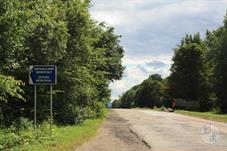 |
 |
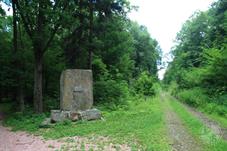 |
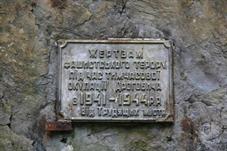 |
| Place of execution of Drohobych Jews | It is located 10 km from the city in the direction of Sambor | ||
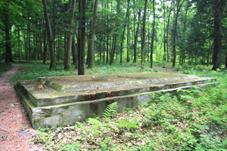 |
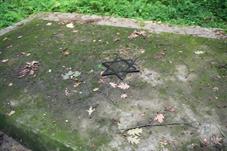 |
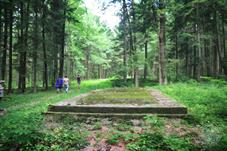 |
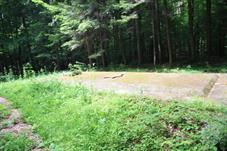 |
| There are more than ten huge graves here | |||
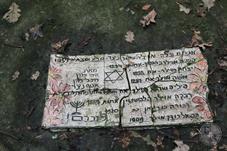 |
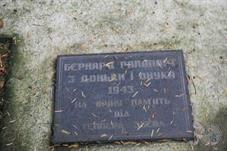 |
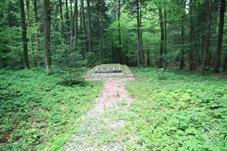 |
 |
Sources:
- Pinkas Hakehillot Polin: Encyclopedia of Jewish Communities, Poland, Volume II, page 160 - 171, published by Yad Vashem, Jerusalem. Translated by Miriam Beckerman, JewishGen, Inc.
Photo:
- Eugene Shnaider
- Pinkas Hakehillot Polin: Encyclopedia of Jewish Communities, Poland, Volume II, page 160 - 171, published by Yad Vashem, Jerusalem. Translated by Miriam Beckerman, JewishGen, Inc.
Photo:
- Eugene Shnaider

- Home
- Shtetls
- Vinnytsia region
- Volyn region
- Dnipro region
- Donetsk region
- Zhytomyr region
- Zakarpattia region
- Zaporizhzhia region
- Ivano-Frankivsk region
- Kyiv region
- Kropyvnytskyi region
- Luhansk region
- Lviv region
- Mykolayiv region
- Odessa region
- Poltava region
- Rivne region
- Sumy region
- Ternopil region
- Kharkiv region
- Kherson region
- Khmelnytskyi region
- Chernihiv region
- Chernivtsi region
- Cherkasy region
- Crimea
- Synagogues
- Cemeteries
- Objects & guides
- Old photos
- History
- Contact
Jewish towns of Ukraine
My shtetl
My shtetl
Donate
Jewish towns of Ukraine
